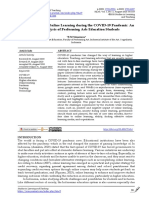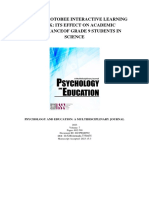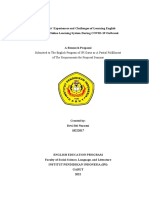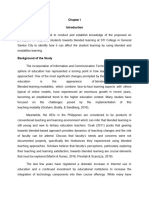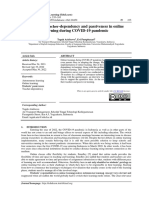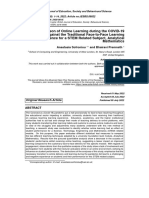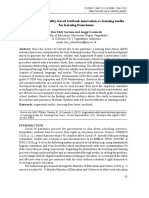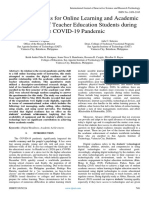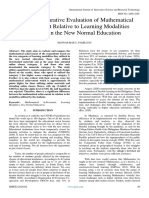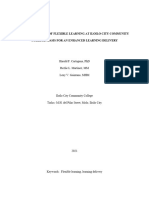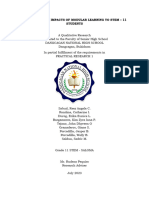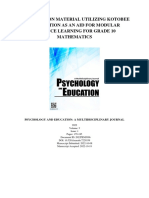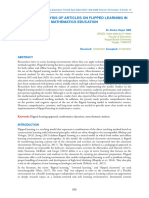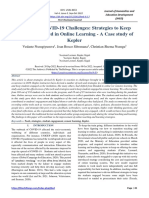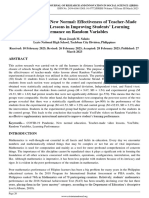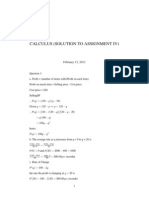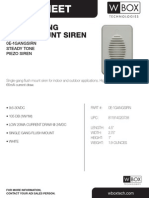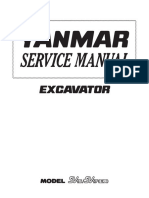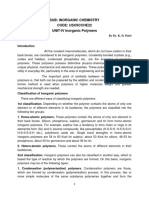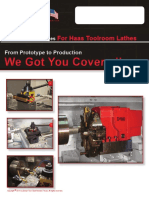Professional Documents
Culture Documents
Attitudes and Performance in Trigonometry Using Blended Learning Among College Students in A State University Amidst Covid-19 Pandemic
Original Title
Copyright
Available Formats
Share this document
Did you find this document useful?
Is this content inappropriate?
Report this DocumentCopyright:
Available Formats
Attitudes and Performance in Trigonometry Using Blended Learning Among College Students in A State University Amidst Covid-19 Pandemic
Copyright:
Available Formats
Volume 7, Issue 10, October – 2022 International Journal of Innovative Science and Research Technology
ISSN No:-2456-2165
Attitudes And Performance In Trigonometry Using
Blended Learning Among College Students In A
State University Amidst Covid-19 Pandemic
Gerry Mae V. Gervacio
Cebu Technological University – Main
IJISRT22OCT867 www.ijisrt.com 1506
Volume 7, Issue 10, October – 2022 International Journal of Innovative Science and Research Technology
ISSN No:-2456-2165
ABSTRACT
Most schools implement blended learning modality to deliver quality education amidst the
COVID-19 pandemic. This study determined the attitudes and performance in Trigonometry using
blended learning among college students in Biliran Province State University, school year 2021-2022
amidst COVID-19 pandemic as basis for an action plan. It employed a descriptive-correlational
research design to gather data regarding the attitudes and performance of the 34 freshman college
Education students who are enrolled in Trigonometry. They responded to two adopted research
questionnaires the Fennema-Sherman Attitudine Scale and the Trigonometry Proficiency Test. The
collected data were treated using frequency, simple percentage, rank, weighted mean, standard
deviation, Chi-square test of independence, and ANOVA. The findings revealed that students are less
proficient in Trigonometry test using blended learning approach despite of their positive attitudes in
Trigonometry. Also, the study shows that age and gender of the students do not have relationships
with their attitudes and performance in Trigonometry. The study concluded that students need to
improve their learning in the subject for these are prerequisites in higher mathematics.The researcher
recommends that the action plan should be implemented, monitored and evaluated to improve the
performance of students in Trigonometry.
Keywords: Teaching Mathematics, Trigonometry, performance, attitudes, descriptive method, Philippines.
IJISRT22OCT867 www.ijisrt.com 1507
Volume 7, Issue 10, October – 2022 International Journal of Innovative Science and Research Technology
ISSN No:-2456-2165
CHAPTER 1
THE PROBLEM AND ITS SCOPE
A. INTRODUCTION
a) Rationale of the Study
The COVID-19 pandemic has shifted the educational landscape from in-person instruction to
blended learning. The preceding health protocols limit movement and disallow students to attend
school physically. Instead of studying in the classroom, students are left at home to digest all the
information being taught online alone without teachers being substantially present as mentors. For
this reason, most students have suffered from psychological, social, financial, and cognitive issues.
From 2020, cities and municipalities will move forward with the new normal of digitizing
information and teaching styles to accommodate social distancing and health protocols. Students
were assigned modules and online classes to amend the mandated learning form, blended learning,
during COVID-19. The modules consist of different subjects the students are enrolled in, while the
online classes are used as partial participation virtually to ensure that the module is followed through.
More or less, the involvement of the students requires their full attention because, more often than
not, they are left to study the lessons independently after the online classes. Despite the efforts of the
teachers to fill the gaps, the students are still having a hard time coping with the learning method
introduced by government protocols.
Without attending physical school, students were still able to learn from their classes through
online mentoring and modular learning. E-classes in the new normal are held by teachers and staff in
compliance with quarantine protocols by the Inter-Agency Task Force (IATF) to continue school far
from the actual place of teaching and studying. In essence, this is called blended learning, which is
combined modular instruction and online learning. The use of self-learning modules in teaching is
part of the modular approach. A module is a collection of educational activities structured around a
well-defined subject. It includes elements such as symmetrical narration, classification objectives,
enriching cognitive actions, and international criterion-referenced measurements for evaluation. The
purposes of a module are clearly articulated, preferably in experiential form. Further, online learning
is a type of education in which students learn from the comfort of their homes via their personal
computers.
In the teaching and learning of Trigonometry, students encounter problems that are difficult to
solve in face-to-face learning. They may lack interest, motivation, and a positive attitude, and some
are not meant to specialize in it, so they pay little or no attention to understanding Trigonometry
concepts. As a result, a blended learning approach can boost students' interest and positivity. Blended
learning encourages active learning and interaction between students and the learning environment's
mediator. Also, using blended learning helps diversify the instructional delivery in Trigonometry.
Attitudes toward learning Trigonometry are essential to consider for college students. Their
negative attitudes toward Trigonometry may affect their performance in the subject using blended
learning.
As observed by the researcher as a teacher in Trigonometry, learning the subject using blended
learning seems difficult for students. Learning Trigonometry was hinted at as inefficient because of
students' attitudes toward Trigonometry. Cognitive issues of students make the matter worse because
of vague learning content, overloaded lessons, and a poor learning environment. The overall attitude
of students was regressing their interest because of too many nuisances accompanied by the learning
modality. This includes unpreparedness and the incapacity to understand the lesson.
IJISRT22OCT867 www.ijisrt.com 1508
Volume 7, Issue 10, October – 2022 International Journal of Innovative Science and Research Technology
ISSN No:-2456-2165
This study aims to determine the attitudes and performance of students in Trigonometry lessons
using blended learning at Biliran Province State University. It has been almost two years since the
blended learning approach was implemented. Thus, the researcher finds it essential to study students'
performance in Trigonometry.
b) Theoretical Background
This research is based on Kolb’s Experiential Learning Theory (1984), Social Learning Theory by
Albert Bandura (1977), and Constructivism Theory by Jerome Bruner (1960). Furthermore, this
study is supported by the following legal bases: R.A. 9155 [Governance of Basic Education Act of
2001], DepEd Order No. 21, series 2019 [Policy Guidelines on the K to 12 Basic Education
Program], and DepEd Order No. 1, series 2021 [Policy on the Evaluation of SLMs for Quarter 3 and
4 for Quarters 3 and 4, the School Year 2020-2021].
David Kolb's Theory of Experiential Learning is one of the humanistic and constructivist
approaches to education that emphasizes natural learning as it emphasizes learning through reflection
on doing (Gadola& Chindamo, 2019). Kolb proposed that experience was critical in developing
knowledge construction, as learning occurs through discovery and active participation (Morris, 2020;
Ng et al., 2019).
Kolb's Experiential Learning Theory is divided into two parts. The first is that learning occurs in
four stages. Kolb believed that, in an ideal world, learners would progress through the process stages
due to their transformation and experiences into knowledge (McLeod, 2017). The second section of
Kolb's Theory concentrated on learning styles, or cognitive processes for acquiring knowledge
through a learning cycle (Yusofet al., 2020). Kolb believed that individuals could learn effectively
and better by reflecting upon previous experiences and creating an improved and better experience
(Idris et al., 2020).
Completing all stages of the cycle allows the transformation of experience into knowledge.
Kolb's entire theory is based on the process by which knowledge is created through experience
transformation (Pamungkas et al., 2019). Given Kob’s cycle, students cannot learn by simply
watching or reading something but through engagement (Widiastuti&Budiyanto, 2018). Students
should ideally be able to progress through each stage.
IJISRT22OCT867 www.ijisrt.com 1509
Volume 7, Issue 10, October – 2022 International Journal of Innovative Science and Research Technology
ISSN No:-2456-2165
THEORIES LEGAL BASES
DepEd Order No. 21, series 2019
Experiential Learning Theory
[Policy Guidelines on the K to 12
(Kolb, 1984)
Basic Education Program]
Social Learning Theory
R.A. 9155 [Governance of Basic
(Bandura, 1977)
Education Act of 2001]
Constructivism Learning Theory
DepEd Order No. 1, series 2021
(Bruner, 1960)
[Policy on the Evaluation of SLMs,
School Year 2020-2021].
ATTITUDES AND PERFORMANCE
IN TRIGONOMETRY USING
BLENDED LEARNING AMONG
COLLEGE STUDENTS
AMIDST THE
COVID-19 PANDEMIC
Action Plan
Fig. 1: Conceptual Framework of the Study
Kolb's theory revolves around experiences, which he saw as a process by which something must be
changed or transformed (Nhung et al., 2022). Memorization or recollection of ideas taught is not the same as
learning because no value is added to the learner. To be defined as learning, something must be generated
from experience, according to Kolb's model (Chiu 2019).
Albert Bandura's Social Learning Theory emphasizes the relevance of observing, modeling, and
imitating behaviors, attitudes, and emotional reactions (Rumjaun&Narod, 2020). Social learning theory
considers the experiences we get from others or from the environment through observation (Yilmaz et al.,
2019). Albert Bandura (1977) agrees with the behaviorist learning theories of classical conditioning and
operant conditioning in social learning theory.
IJISRT22OCT867 www.ijisrt.com 1510
Volume 7, Issue 10, October – 2022 International Journal of Innovative Science and Research Technology
ISSN No:-2456-2165
The three theories are connected to my study because learning Trigonometry occurs naturally because
they understand the lessons. After all, the function of their minds allows them to. Further, they progress
throughout the studying cycle due to the tendency to answer and comprehend the lesson step-by-step. Lastly,
they can transform this experience into a learning mechanism because they interact with their teachers and
classmates.
Learning is a relatively lasting change in behavior resulting from experience (Cherry 2022). As most
parents are probably very much aware, observation can play a critical role in determining how and what
children learn. As the saying goes, kids are like sponges, soaking up their daily experiences. Albert Bandura
posited a social learning theory in which observation and modeling are central to the process.
Bandura's theory moves beyond behavioral theories, which suggest that all behaviors are learned
through conditioning, and cognitive theories, which consider psychological influences such as attention and
memory (Bandura, 2021).
Constructivist Theory by Jerome Bruner in 1960, where students actively build their knowledge based
on relevant experiences, so the new knowledge comes as the old ones are the foundation. Students can
discover and explore learning; prior knowledge is essential to learning (Heo et al., 2018; Kang et al., 2017).
Constructivism has been a compelling model for explaining how knowledge is produced globally and how
students learn (Shah, 2019). In MDL, understanding the module starts with the students.
Following its legal mandate, DepEd has promulgated flexible learning and materials issuances,
specifically, DepEd Order No 21, series 2019, or the Policy Guidelines on the K-to-12 Basic Education
Program. It sets forth flexible learning options [FLOs], including alternative delivery modes and related
learning resources responsive to learners' needs, context, circumstances, and diversity. These policy
guidelines aim to establish the standards and specifications for providing learning resources in implementing
the BE-LCP. The learning resources serve as learning toolkits for learners, containing procedures,
instructions, and other details to aid the learning process under the supervision of responsible adults and
teachers who provide continuous monitoring and guidance.
Republic Act No. 9155, also known as the Governance of Basic Education Act of 2001, stipulatedthe
governance of basic education that must start at the national level. It is a mission to give quality basic
education to all Filipinos, making education accessible to all. In Section 6, DepEd has the authority,
accountability, and responsibility to ensure access to, promote equity in, and improve the quality of basic
education, which must continue even during COVID-19. This is the basis of creating the Basic Education
Learning Continuity Plan [BE-LCP].
To ensure the quality of SLMs being used in the MDL modality, DepEd issued guidelines on evaluating
SLMs, particularly those used by students in the coming grading periods. DepEd Order No. 1 series 2021
issued policy guidelines on evaluating SLMs for Quarters 3 and 4 for the school year 2020-2021. SLM has
become a supplemental means of learning in new normal education (Bacomo et al., 2022). The primary
learning resource for MDL is the present educational setup.
According to Ackbarov and Aydogan (2018), blended learning serves students' educational needs by
improving student satisfaction, increasing choice and ease, acquiring and improving language skills, and
improving critical thinking.
According to them, pupils are satisfied with blended learning and appreciate this innovative form of
teaching. Students with a positive attitude toward learning and are highly motivated to learn also have a
positive attitude toward online learning in blended courses. In general, using the blended learning
methodology to teach Trigonometry extensively influences pupils' perceptions of the subject.
IJISRT22OCT867 www.ijisrt.com 1511
Volume 7, Issue 10, October – 2022 International Journal of Innovative Science and Research Technology
ISSN No:-2456-2165
A printed self-learning module is essential to aid distance learning in continuing the students' basic
education (Tupas & Linas-Laguda, 2020; Baruah, 2018; ). As a continued learning modality in the middle of
the COVID-19 crisis, the result of the study will be beneficial to the learners to rigorously implement self-
discipline in time management and set daily priorities to accomplish every single task stipulated in the self-
learning module. Moreover, the learners will also learn to develop strong self-reliance and a positive attitude
toward independent learning (Mashitoh, et al., 2021).
The rapid spread of COVID-19 has sparked worldwide concern. The government announced the closure
of educational institutions as a precautionary measure to combat this outbreak (Libasin et al., 2021).
Universities have the mission of promoting social, cultural, and economic development. Adopting flexible
learning pathways strategies has been essential to facilitate students' access and creating an inclusive
learning environment (Rey-Naizaque, 2021).
According to the Aksan (2021) study, students' perceptions agreed on using the modular distance
learning approach (MDLA). It means that the students had favorable views of MDLA in mathematics. The
study also found that students who agreed to use the modular distance learning approach (MDLA) in math
faced a few difficulties. It also positively affected students' performance; students performed very
satisfactorily in Mathematics, which means they had a good quality performance. However, when the
students were grouped by gender and age, there was no significant difference in their perceptions, indicating
that they all had the same perceptions.
The study of Fadillah et al. (2020) concluded that students' average level of mathematical disposition
was classified as moderate. Only the monitor and evaluate indicators are classified as a high category if seen
from the indicators. Indicators of persistence and perseverance, especially when lecturers present interesting
contextual problems.
COVID-19 forced universities to improvise and adopt online learning and teaching rapidly. Minor
changes to teaching design and delivery are required for effective teaching continuously. This is an
ambidextrous approach to education in which teachers concentrate on the immediate co-creation of student
experiences and identify cues used to adjust how they interact with a student cohort throughout a module.
Module evaluation evolves into a continuous process in which changes are made in real-time, and
subsequent student-learning encounters are observed (Thomas & Bryson, 2021).
Wang et al. (2021) examined the relationships between the role of the instructor and university
students’ learning outcomes in cloud-based classrooms during the COVID-19 pandemic. The study revealed
that the students' perceived learning outcomes and satisfaction were positively related to instructor
innovation and negatively related to instructor performance. Instructional support was positively associated
with the students' perceived learning outcomes but not directly related to their learning satisfaction. The
student's academic self-efficacy mediated the influence of instructional support and instructor innovation on
their perceived learning outcomes and satisfaction. The results contribute to instructors' role in facilitating
students' learning outcomes in higher education and suggest ways to improve the learning environment and
outcomes, especially in cloud-based virtual classrooms.
The COVID-19 pandemic has affected many countries, causing school closures and a shift from face-
to-face and online learning methods. Yohannes et al. (2021) discovered that several factors, including
students, teachers, the school, curriculum, and parents, contributed to teachers' difficulties in implementing
online learning. Students and teachers posed significant challenges. As a result, it was critical to consider
suggestions and efforts to overcome teachers' challenges in implementing online learning. Coordination and
collaboration among the government, schools, teachers, students, and parents are critical to the success of
online learning.
IJISRT22OCT867 www.ijisrt.com 1512
Volume 7, Issue 10, October – 2022 International Journal of Innovative Science and Research Technology
ISSN No:-2456-2165
Blended learning incorporates online learning experiences and assists students in meaningful learning
through flexible online information and communication technologies, reduced overcrowding in the
classroom, and planned teaching and learning experiences. As a result, blended learning benefits school,
university, and professional training. An extensive set of online and e-learning platforms have been
developed recently to be used in blended learning to improve learners' abilities. Using similar tools
(Blackboard, CodeTantra, and g suite), the two universities met their requirements and completed all
academic activities on time during the pandemic (Kumar et al., 2021).
Blended learning using Desmos alongside platforms such as Zoom can successfully engage students in
the learning experience due to its facility to give students and teachers instant feedback about the learning
taking place, which is developmental for the students. However, suppose blended learning is to be
successfully used in this way. In that case, it is vital that students can study in an appropriate environment
and that they have access to the right technology. If blended learning takes place in a classroom setting, this
will mean that there needs to be enough computers/laptops/tablets for each student (Lethbridge et al., 2021).
There is a need to develop practical online learning courses or programs that promote critical thinking
as a crucial competence of higher education. The study of Varenina et al. (2021) shows a correlation
between preferred learning styles and levels of critical thinking, which must be considered when developing
the online learning curriculum and lesson plans. The study results will enable students to organize their
learning better. Teachers can use this information to optimize the course design.
Recent research has focused on understanding teachers' and students' perceptions of online teaching and
learning. The debate over the efficacy of online learning and its future potential continues as the COVID-19
outbreak has made it the best available option under social distancing and quarantine policies. The findings
show the similarities and differences between the two groups regarding the factors influencing online
teaching and learning satisfaction (Lei & So, 2021).
The COVID-19 pandemic has demonstrated the need for tools and methodologies to support students'
autonomous learning and formative assessment practices in distance education contexts, particularly among
students from disadvantaged backgrounds.
According to Barana et al. (2021), feedback is more effective than other activities in engaging learners
in actions to improve their results, and the effects are more substantial in low socioeconomic contexts.
Students become more confident in learning trigonometry and find valuable trigonometry in their daily
lives. Attributes such as performing problem-solving skills and acquiring a positive attitude toward
mathematics could help achieve the mathematics curriculum's aspiration and address the poor performance
in Trigonometry questions. Therefore, the critical role of the teacher is to explain different concepts to the
students and ensure that they understand the material being presented ( Manman&Surajo, 2021).
The results demonstrate that willingness, perseverance, and self-confidence in solving mathematical
problems are essential to ensure outstanding performance.Ngussa and Mbuti (2017) found that enhancing
students’ positive attitudes can boost students’ performance in mathematics.The student's accomplishment in
problem-solving depends on her interest, attitude, and self-confidence. It was discovered that accounting
students lack confidence in solving trigonometric problems compared to life and physical science students.
Therefore, lecturers need to take reasonable measures to enhance students' self-confidence.
Holmes (2020) examined the relationship between the attitudes and components of the student's
attitudes toward math with their mathematics achievements. There were weak relationships between
trigonometric achievement and the five elements of perspectives, including the attitude in trigonometry. The
contribution of all components of attitude in trigonometry collectively significantly affected (but low)
students' achievement in trigonometry. The gift of confidence was significant in the variable trigonometry
achievement, but the other components' usefulness, Enjoyment, the subject is perceived as a male domain,
IJISRT22OCT867 www.ijisrt.com 1513
Volume 7, Issue 10, October – 2022 International Journal of Innovative Science and Research Technology
ISSN No:-2456-2165
and teacher expectations were not significant in the variable trigonometry achievement. Confidence
contributed the greatest to trigonometry achievement in knowledge, comprehension, and application.
Cortez(2020) examined the perception of the students on blended, distance, electronic and virtual
learning. The result indicates that the subjects’perception effectivity of online learning and their capability to
attend the e-learning sessions is independent of their life style and available e-learning tools despite the
result analysis of variance showing that their perceived mathematical capability is significantly different.
Despite teachers' best efforts, students develop trigonometry misconceptions. Furthermore, students'
attitudes toward mathematical lesson inquiry improved significantly. Even though enjoyment of
mathematics lessons remained high, it did not change. Also, for teachers to create a practical learning
experience, they should be aware of and acknowledge students’ prior knowledge acquired from academic
settings and everyday personal experiences. In order to reduce or eliminate some of the difficulties and
encourage knowledge retention in learning Trigonometry, the use of an appropriate method/strategy that
involves students’ active participation in the learning process is paramount.
With all these, this study intends to see students'attitudes toward Trigonometry and their performance in
Trigonometry during the school year 2021-2022 using the bended learning amidst the COVID-19 pandemic.
B. THE PROBLEM
a) Statement of the Problem
This research determined the attitudes and performance in Trigonometry using blended learning
among college students in Biliran Province State University during the school year 2021-2022
amidst the COVID-19 pandemic as the basis for an action plan.
Specifically, it sought answers to the following questions:
1. What is the profile of the respondents in terms of:
1.1 age; and
1.2gender?
2. What is the level of attitudes of the respondents inTrigonometry
in the areas of:
2.1 Confidence in Learning;
2.2 Attitudes Towards Success;
2.3 Mathematics as a Male Domain; and
2.4 Usefulness?
3. What is the performance of the respondents in Trigonometry?
4. Is there a significant relationship between the profile of the respondents and
their:
4.1 level of attitudes toward Trigonometry; and
4.2 performance in Trigonometry?
5. When grouped by profile, is there a significant difference in the:
5.1 level of attitudes toward Trigonometry; and
5.2 performance in Trigonometry?
6. Based on the findings, what action plan may be drafted?
b) Statement of Null Hypotheses
The following null hypotheses were tested at the 0.05 level of significance.
Ho1: There is no significant relationship between the profile of the respondents
and their:
a. level of attitudes toward Trigonometry; and
b. performance in Trigonometry.
IJISRT22OCT867 www.ijisrt.com 1514
Volume 7, Issue 10, October – 2022 International Journal of Innovative Science and Research Technology
ISSN No:-2456-2165
Ho2: When grouped by profile, there is no significant difference in the:
a. level of attitudes toward Trigonometry; and
b. performance in Trigonometry.
c) Significance of the Study
The findings of the study would benefit the following stakeholders.
Commission on Higher Education. The results of this study will assist the Commission as a
comprehensive guide for them in enhancing the Trigonometry curriculum for teachers to use in
delivering quality teaching and learning within the walls of the academe.
School Administrators. The administration can implement school ordinances to augment the
detrimental effects of the COVID-19 pandemic on their local institution. This will serve as guiding
research that could attest to the memorandum that the school can release.
Teachers. This study will use the flexible learning approach to improve teachers' teaching skills in
handling college students who have difficulty teaching Trigonometry. Teachers may review their
teaching strategies to adjust their lecture styles better suit their needs.
Guidance Counselors. Psychometricians and psychologists can advise more comprehensive
solutions to the students regarding psychosocial, financial, and intellectual factors that degrade
their learning capabilities.
Students. The students can understand the root causes of the issues encountered in blended
learning. When enlightenment happens, the student can create better study habits incorporated with
the action plan against the problems faced in Trigonometry lessons.
Parents. The parents can be supported with the proper methods that can be used to guide their
children as students properly. More encouragement, among other forms of moral and physical
assistance, augment the difficulties their children feel as students.
Researcher. This study will help him become effective in teaching Trigonometry. Through this
study, she can widen her knowledge base on the different topics of Trigonometry on how to
improve her teaching.
Future Researchers. The findings and interpretation will reference future research on related
topics with different variables not identified.
C. RESEARCH METHODOLOGY
This part presents the methods used in this study, particularly the research design, research environment,
research respondents, research instrument, data gathering procedure, statistical treatment of data, and data
scoring.
a) Design
This study employed a descriptive correlational study by analyzing quantifiable data gathered using a
population survey. A descriptive correlational research design is a method in which the researcher is
particularly interested in documenting naturally occurring connections between variables. The
study's primary goal is to obtain an overview of the current situation and evaluate the relationships
among two or more variables.
b) Flow of the Study
The IPO model represents the input, process, and output stages. Inputs are represented by materials
and efforts delivered to a system at the start of its lifecycle. Outputs are defined as the system's final
result.
The profile of the respondents, such as their age and gender, their level of attitudes toward
Trigonometry, includes Confidence in Learning, Attitudes Towards Success, Mathematics as a Male
Domain, and Usefulness, and their performance in Trigonometry using the blended learning
approach are the inputs of the study.
IJISRT22OCT867 www.ijisrt.com 1515
Volume 7, Issue 10, October – 2022 International Journal of Innovative Science and Research Technology
ISSN No:-2456-2165
In the Process approach, the researcher submitted a transmittal letter seeking approval to
conduct the study.
IN P U T PROCESS O U TP U T
Descriptive
Correlational Method
Gathering of Data
Submission of
transmittal letter
Administration of
attitudinal scale
toward
Trigonometry
1. Profile of the Conduct of
respondents performance in
Trigonometry to
2. Level of attitudes respondents
toward Trigonometry
of the respondents Tabulation of Data Action Plan
Encoding of Data
3. Performance in into the Data
Trigonometry of the Matrix
respondents Conducting Data
Hygiene
4. Test of Significant
Relationship Analysis of Data
Treatment using
5. Test of Significant Minitab statistical
Difference software
Interpretation of Data
Fig. 2: Flow of the Study
IJISRT22OCT867 www.ijisrt.com 1516
Volume 7, Issue 10, October – 2022 International Journal of Innovative Science and Research Technology
ISSN No:-2456-2165
Once approved, the researcher administered the attitudinal scale toward Trigonometry to the identified
respondents of the study. Then, shortly after, she conducted the performance test in Trigonometry. Once
completed, the researcher collected the accomplished instrument and encoded the respondents’ responses
into a Data Matrix file. To make sure that the data are error-free, she hygiene the data. The data were then
analyzed using Minitab statistical software and interpreted using the existing literature to strengthen its
discussions.
Using a blended learning approach, an action plan was drafted to improve the student's performance in
Trigonometry.
c) Environment
This study was conducted at Biliran Province State University (BiPSU), founded in 1965. It is a non-
profit public higher education institution located in the small city of Biliran, Eastern Visayas. In
Biliran, this institution has a branch campus.
BiPSU is a result of the elevation or conversion of the Naval State University, formerly Naval
Institute of Technology, under No. 11170 of the Republic Act. The aforementioned legislative bill
results from the academic community's and the Biliranons' collective efforts, unending prayers, and
noble dreams.
On October 30, 1945, the late Acting Mayor Pablo Caneja signed Municipal Resolution No. 35,
establishing an intermediate public high school in Naval, a municipality in the Philippines' Biliran
province.
IJISRT22OCT867 www.ijisrt.com 1517
Volume 7, Issue 10, October – 2022 International Journal of Innovative Science and Research Technology
ISSN No:-2456-2165
Fig. 3: Location Map of the Research Environment
The Naval High School was founded in 1946 and functioned from 1946 to 1947. After decades of
operation, late Congressman Marcelino Veloso introduced a bill signed into law on June 19, 1965,
transforming Naval High School into a chartered state college under Republic Act 4309.
IJISRT22OCT867 www.ijisrt.com 1518
Volume 7, Issue 10, October – 2022 International Journal of Innovative Science and Research Technology
ISSN No:-2456-2165
The institution was converted for national support under the direction of the first president, Mr. Alfredo
C. Joseph. Gerry Boy Espina, a former congressman from Biliran's lone district, proposed that the Naval
Institute of Technology (NIT) be turned into a state university under the name Biliran State University.
Biliran Province State University (BiPSU) offers courses and programs leading to officially recognized
higher education degrees such as bachelor's, master's, and doctorate degrees in various fields of study. Its
mission is to provide academic degrees, higher technological, specialized education, and training in arts and
sciences, agriculture, fishing, forestry, maritime education, information & communication technology,
engineering, tourism, and other related disciplines. It is also required to perform research, provide
institutional capacity, and give contemporary management in its areas of expertise. In the town of Biliran,
Biliran runs an extension campus (BiPSU FB, 2022).
d) Respondents
The respondents were 34 freshmen Bachelor in Secondary Education students majoring in
Mathematics. Using Blended Learning, they are enrolled in Trigonometry during the second
semester of the school year 2021-2022. Since participants are selected depending on their
availability, willingness, and eligibility to engage in the study, the researcher applied non-probability
convenience sampling.
e) Instruments
This study employed two sets of questionnaires to collect quantitative data from Bachelor of
Secondary Education students enrolled in Trigonometry.
The first instrument contains two parts. Part 1 gathers the respondents' profiles, including their
age and gender. Part 2 gathers the respondents' attitudes in Trigonometry using a standardized
instrument such as the Fennema-Sherman Mathematics Attitude Scales. This part has four areas: a)
Confidence in Learning, b) Attitudes Towards Success, c) Mathematics as a Male Domain and d)
Usefulness. In this section, the respondents answered using the 4-Likert scale: 4 points for Strongly
Agree, 3 points for Agree, 2 points for Disagree, and 1 point for Strongly Disagree. The respondents
were advised to put a checkmark corresponding to their feelings about the items on the attitudinal
scale.
The second instrument is a standardized Trigonometry Proficiency Test to measure the student's
performance in Trigonometry. It has a 40-item multiple-choice type of test. The students were
advised to choose their answers by encircling the letter of their choice.
f) Data Gathering Procedure
Preliminary Stages. The researcher has invested significant time, effort, and collaboration in
constructing the questionnaire to serve the intended respondents. The survey questionnaire
comprises relevant questions that have been updated according to the accepted conceptual
framework of the researcher's supervisor. Due to the COVID-19 outbreak, the instrument was
converted into a Google form. The researcher then sent a letter to the program director's office,
suggesting a study be done there.
Data Gathering Procedure. The survey questionnaire was distributed using the Internet once the
Board had given a signal to proceed with the gathering of data. The data were gathered at least two
weeks to disseminate the form and get enough respondents. The researcher then automatically
retrieved the survey questionnaire.
Post Data Gathering Stage. After garnering the sample respondents, the data were statistically
treated. Statistical interpretations were supported with professional recognition when representing
significant results, conclusions, and actions.
IJISRT22OCT867 www.ijisrt.com 1519
Volume 7, Issue 10, October – 2022 International Journal of Innovative Science and Research Technology
ISSN No:-2456-2165
Data Privacy. Formal consent was sought from the schools and respondents with the permission of
the college deans. Respondents were assured that the information gathered would be kept strictly
confidential. Their responses and information gathered were used only for research purposes.
Ethical Considerations. The researcher ensured that the participants' confidentiality was respected
and maintained. The researcher needed respondents to fill out a consent form before they could
begin answering the online questionnaires. The consent form's concept is that the researcher
provided enough information and verification about the study to allow participants to be fully
informed about the benefits of participating in the research and make an informed and freely given
decision about whether or not to participate without being coerced. Only authorized personnel,
such as the researcher, were given access to all the information acquired and retrieved from the
participants.
This research has ethical implications for addressing and promoting the search for knowledge and truth
by preventing data fabrication or falsification. To avoid such hazards, the participants in this study are
informed of everything they need to know about the study's purpose, duration, and process. It is entirely up
to you whether or not you choose to participate in this study. The participants will not be forced to
participate in the study if they do not want to. If, for any reason, participants choose to withdraw from the
investigation once it has begun, they may do so without being questioned. There will be no pressure on the
participants to continue. There will be no negative consequences if you decline or withdraw from the study.
Throughout the survey procedures, the researcher complied with the ethical research considerations.
Before responding to the computerized questionnaire, the researcher obtained informed consent from the
respondents. The researcher kept the respondents' sensitive information and identities protected.
The researcher followed ethical research guidelines throughout the survey methods. The respondents
gave their informed consent to the researchers before responding to the computerized questionnaire. The
researcher kept all of the respondents' personal information and identities safe.
g) Statistical Treatment of Data
The researcher used the following statistical formulas to treat the gathered data from the respondents.
To treat the gathered data on the profile of the respondents, frequency, simple percentage, mean,
and standard deviation were used.
To treat the gathered data on the level of attitudes toward Trigonometry of the respondents,
weighted mean and standard deviation were used.
To treat the gathered data on the respondents' level of performance in Trigonometry, frequency,
simple percentage, mean, and standard deviation were used.
On the test of the significant relationship between the profile of the respondents and their level
of attitudes and performance in Trigonometry, the Chi-square test of independence was used.
ANOVA tested the significant differences in attitudes toward Trigonometry and its level of
performance in Trigonometry when grouped by its profile.
IJISRT22OCT867 www.ijisrt.com 1520
Volume 7, Issue 10, October – 2022 International Journal of Innovative Science and Research Technology
ISSN No:-2456-2165
h) Scoring Procedure
The following with parametric scaling was used to determine students' attitudes toward
Trigonometry.
Scale Numerical Descriptive Rating Verbal Interpretation
4 3.25 - 4.00 Very Positive The respondents strongly agree with the statements.
3 2.50 - 3.24 Positive The respondents agree with the statements.
2 1.75 - 2.49 Negative The respondents disagree with the statements.
1 1.00 - 1.74 Very Negative The respondents strongly disagree with the statements.
The following with parametric scaling was used to determine students' performance in Trigonometry.
Scoring Range Descriptive Rating Verbal Description
40 Excellent 100% of the test the student has answered correctly.
31 - 39 Very Proficient 76% to 90% of the test the student has answered correctly.
21 - 30 Proficient 51% to 75% of the test the student has answered correctly.
11 - 20 Less Proficient 26% to 50% of the test the student has answered correctly.
1 - 10 Poor 0% to 25% of the test the student has answered correctly.
D. DEFINITION OF TERMS
The following terms are operationally and conceptually defined.
Attitudes Toward Trigonometry. This study refers to students' behavior in learning Trigonometry,
which includes the students’ Confidence in Learning, Attitude Towards Success, Mathematics as a
Male Domain, and Usefulness in Trigonometry.
Basic Education Learning Continuity Plan. This refers to activities to ensure students' learning
progress amidst natural calamities, storms, fires, and pandemics.
Blended Learning. This is a learning method that combines face-to-face teaching and online
instruction--ideally leveraging the strengths of each.
Covid-19 Pandemic. An infectious disease caused by the SARS-CoV-2 virus that brought lockdown
and health protocols closing HEIs.
Learning Activity Sheet. This provides information and instruction, the method for engaging in
activities, and links to publications and independent media to better the educational landscape.
Performance in Trigonometry. This study refers to scores the students earned in Trigonometry
deemed necessary to them in learning the subject despite the pandemic. It includes polynomials,
expressions, equations, and the like.
Profile of the Respondents. This refers to the age and gender of the college students enrolled in
Trigonometry classes.
Self-Learning Modules (SLMs). In this study, teachers developed materials to improve students'
learning in Trigonometry.
Trigonometry. This study refers to the subject enrolled by college students at Biliran Province State
University. It includes the characters and other fundamental symbols used to represent parameters and
variables in equations and calculations in this branch of mathematics.
IJISRT22OCT867 www.ijisrt.com 1521
Volume 7, Issue 10, October – 2022 International Journal of Innovative Science and Research Technology
ISSN No:-2456-2165
CHAPTER 2
PRESENTATION, ANALYSIS, AND INTERPRETATION OF DATA
This chapter presents the data's descriptive analysis, evaluation, correlation, and information gathered.
A. Profile of the Respondents
Table 1 presents the profile of the respondents.
Profile Frequency Percentage Rank
Age [in years]
27 - 28 1 2.94 3
25 - 26 1 2.94 3
21 - 22 6 17.65 2
19 - 20 20 58.82 1
17 - 18 6 17.65 2
Mean : 19.74
StDev : 2.23
Gender
Male 11 32.40 2
Female 23 67.60 1
Table 1: Profile of the Respondents
The respondents were 34 freshmen Bachelor in Secondary Education students majoring in
Mathematics. Using Blended Learning, they are enrolled in Trigonometry during the second semester of the
school year 2021-2022. Since participants are selected depending on their availability, willingness, and
eligibility to engage in the study, the researcher applied non-probability convenience sampling.
As depicted inTable 1, in terms of the age profile of the students, it can be gleaned that most
respondents are 19 to 20 years old (58.82%). This is followed by 17 to 18 years old and 21 to 22 years old
with six respondents (17.65%). Also, the table revealed 23 female and 11 male respondents in the study.
IJISRT22OCT867 www.ijisrt.com 1522
Volume 7, Issue 10, October – 2022 International Journal of Innovative Science and Research Technology
ISSN No:-2456-2165
B. LEVEL OF ATTITUDES OF THE RESPONDENTS TOWARD TRIGONOMETRY
a) Confidence in Learning of the Respondents
Table 2 presents the overall mean for the level of confidence in learning of the respondents.
(N = 34)
Indicators Weighted Mean StDev Verbal Interpretation
1. I have felt secure about attempting 3.06 0.42 Positive
Trigonometry.
2. I am sure I could do advanced work in 2.88 0.59 Positive
Trigonometry.
3. I am sure that I can learn Trigonometry. 3.32 0.47 Very Positive
4. I think I could handle more difficult 2.68 0.53 Positive
Trigonometry.
5. I can get good grades in Trigonometry. 3.03 0.52 Positive
6. I have a lot of self-confidence when it comes 2.68 0.53 Positive
to Trigonometry.
7. I am no good at Trigonometry. 2.38 0.74 Negative
8. I do not think I could do advanced 2.50 0.66 Agree
Trigonometry.
9. I am not the type to do well in Trigonometry. 2.41 0.78 Negative
10. For some reason, even though I study, 2.65 0.73 Positive
Trigonometry seems unusually hard for me.
11. Most subjects I can handle are okay, but I have 2.82 0.67 Positive
a knack for messing up.
12. Trigonometry has been my worst subject. 1.91 0.57 Negative
Overall Mean 2.69 0.60 Positive
Table 2: Confidence in Learning of the Respondents
Range: 1.00-1.74 Very Negative; 1.75-2.49 Negative; 2.50-3.24 Positive; 3.25-4.00 Very Positive
Table 2 shows that the overall mean for the level of confidence in learning was 2.69 (Positive), with a
standard deviation of 0.60. This indicates that the student's acceptance of the confidence in learning about
trigonometry was viewed favorably.
Also, the table shows that the indicator, “I am sure that I can learn Trigonometry," got the highest mean
of 3.32 (Very Positive) with a standard deviation of 0.47. While the indicator, “Trigonometry has been my
worst subject," got the lowest mean of 1.91 (Negative) with a standard deviation of 0.57.
This implies to the study that their confidence level is affected by their security in attempting
Trigonometry, which entails that because they agree that they are secure, they are more confident in their
learning of Trigonometry. Due to this, they also agree that they are sure they could do advanced work in
Trigonometry.
It is seen that they are confident because of their answers that they can handle difficult work in
Trigonometry, and they will get good grades in Trigonometry, accentuating their agreement on self-
confidence in Trigonometry. This is strengthened when they disagree with the idea that they are bad at
Trigonometry. However, the students are also honest, stating they agree with the concept that they cannot
handle advanced Trigonometry because it seems unusually hard for them.
IJISRT22OCT867 www.ijisrt.com 1523
Volume 7, Issue 10, October – 2022 International Journal of Innovative Science and Research Technology
ISSN No:-2456-2165
b) Attitudes Towards Success of the Respondents
Table 3 presents the attitudes towards success of the respondents.
(N = 34)
Weighted Verbal
Indicators StDev
Mean Interpretation
1. It would make me happy to be recognized as an excellent 3.29 0.52 Very Positive
student in Trigonometry.
2. I would be proud to be an outstanding student in 3.50 0.51 Very Positive
Trigonometry.
3. I would be happy to get top grades in Trigonometry. 3.53 0.56 Very Positive
4. It would be really great to win a prize in Trigonometry. 3.29 0.52 Very Positive
5. Being first in a Trigonometry competition would make 3.06 0.42 Positive
me pleased.
6. Being regarded as smart in Trigonometry would be a 3.29 0.52 Very Positive
great thing.
7. Winning a prize in mathematics would make me feel 2.41 0.56 Negative
unpleasantly conspicuous.
8. People would think that I was some kind of creep if I got 2.21 0.54 Negative
A's in Trigonometry.
9. If I got the highest grade in Trigonometry, I would try to 2.21 0.77 Negative
hide it.
10. If I got the highest grade in math, I would prefer that no 2.27 0.79 Negative
one knew.
11. It would make people like me less if I were a really good 2.15 0.66 Negative
Trigonometry student.
12. I do not like people to think I am smart in Trigonometry. 2.50 0.79 Positive
Overall Mean 2.81 0.60 Positive
Table 3: Attitudes Towards Success of the Respondents
Range: 1.00-1.74 Very Negative; 1.75-2.49 Negative; 2.50-3.24 Positive; 3.25-4.00 Very Positive
Table 3 shows that the overall mean for the level of attitudes toward success was 2.81 (Positive), with a
standard deviation of 0.60. This implies understanding how certain different but interrelated variables such
as background, motivation, and social support could explain student attitudes towards Trigonometry and an
understanding of the defining characteristics of these attitudes in the blended learning approach.
Also, the table shows that the indicator, “I would be happy to get top grades in Trigonometry," got the
highest mean of 3.53 (Very Positive) with a standard deviation of 0.56. While the indicator, “It would make
people like me less if I were a really good Trigonometry student," got the lowest mean of 2.15 (Negative)
with a standard deviation of 0.66.
This implies that attitudes toward success rely on Trigonometry among the respondents. Winning in
Trigonometric competitions and having high grades in Trigonometry make them a person who is happy that
they won and have subjects like Trigonometry. This entails that they disagree that having high grades in
Trigonometry makes you creep. The respondents also frown on being shy or not letting anyone know that
they have high grades in Trigonometry. This means that attitudes towards success are affected positively by
Trigonometry.
IJISRT22OCT867 www.ijisrt.com 1524
Volume 7, Issue 10, October – 2022 International Journal of Innovative Science and Research Technology
ISSN No:-2456-2165
Although the results cannot be interpreted as indicating a causal relationship between positive emotions
and achievement, the results indicate how positive emotions in mathematics learning can contribute to a
more balanced picture of the role of affective states in mathematics learning (Daker et al., 2021).
c) Mathematics as a Male Domain
Table 4 presents the overall mean for the Mathematics as male domain.
(N = 34)
Weighted Verbal
Indicators StDev
Mean Interpretation
1. Females are as good as males in Trigonometry. 2.97 0.90 Positive
2. Studying Trigonometry is just as appropriate for women as 2.94 0.89 Positive
for men.
3. I would trust a woman just as much as I would trust a man 3.24 0.74 Positive
to figure out important calculations.
4. Girls can do just as well as boys in Trigonometry. 3.41 0.74 Very Positive
5. Males are not naturally better than females in Trigonometry. 2.24 0.65 Negative
6. Women certainly are logical enough to do well in 2.62 0.82 Positive
Trigonometry.
7. It is hard to believe a female could be a genius in 2.06 0.78 Negative
Trigonometry.
8. When a woman has to solve a Trigonometry problem, it is 2.27 0.71 Negative
feminine to ask a man for help.
9. I would have more faith in an answer to a Trigonometry 2.00 0.70 Negative
problem solved by a man than a woman.
10. Girls who enjoy studying Trigonometry are a bit peculiar. 2.29 0.80 Negative
11. Trigonometry is for men. Arithmetic is for women. 1.88 0.64 Negative
12. I would expect a woman mathematician to be a masculine 1.97 0.58 Negative
type of person.
Overall Mean 2.49 0.75 Negative
Table 4: Mathematics as a Male Domain
Range: 1.00-1.74 Very Negative; 1.75-2.49 Negative; 2.50-3.24 Positive; 3.25-4.00 Very Positive
Table 4 shows that the overall mean for the level of mathematics as a male domain was 2.49 (Negative)
with a standard deviation of 0.75. This implies that students tended not to stereotype mathematics as a male
domain, but to the extent of stereotyping, males were stereotyped more than females. There have been
changes in social attitudes about females and mathematics, but the issue of gender equity in mathematics
continues.
Also, the table shows that the indicator, “Girls can do just as well as boys in Trigonometry," got the
highest mean of 3.41 (Very Positive) with a standard deviation of 0.74. While the indicator, “Trigonometry
is for men. Arithmetic is for women," got the lowest mean of 1.88 (Negative) with a standard deviation of
0.64.
This implies to the study that males and females have an equal capacity to perform in Trigonometry and
that male dominance in Trigonometry is not persisting. The respondents agreed that females are as good as
males in Trigonometry. The respondents have a boosted confidence that Females can be trusted for
calculations and that Trigonometry can be studied as appropriate by females, the same as males. This entails
that females are logical beings like males who can handle Trigonometry. This resulted in a disagreement that
Males are better than females when it comes to Trigonometry or that females are not logical enough to
IJISRT22OCT867 www.ijisrt.com 1525
Volume 7, Issue 10, October – 2022 International Journal of Innovative Science and Research Technology
ISSN No:-2456-2165
handle and study Trigonometry as that males. They also disagreed that women mathematicians are the
masculine type of people or peculiar. This means they disagree that Trigonometry is just for males and that
females are mere arithmetic solvers.
Students who were able to solve problems with procedural skills will still be able to obtain good marks
in the examinations, although they may have a weak conceptual understanding of trigonometry. The
students, for sure, may obtain excellent marks for the examinations, but the knowledge retained may be
short-term.
The study byZamora et al,. (2019) found that may be taken as evidence because when students
obtained good marks after they had learned the lesson recently and produced unsatisfactory marks.
d) Usefulness of Trigonometry
Table 5 presents the usefulness of mathematics concerning respondents.
(N = 34)
Weighted Verbal
Indicators StDev
Mean Interpretation
1. I will need Trigonometry for my future work. 3.03 0.67 Positive
2. I study Trigonometry because I know how useful it is. 3.03 0.63 Positive
3. Knowing Trigonometry will help me earn a living. 2.85 0.74 Positive
4. Trigonometry is a worthwhile and necessary subject. 3.03 0.72 Positive
5. I will need a firm mastery of Trigonometry for my future work. 2.85 0.78 Positive
6. I will use Trigonometry in many ways as an adult. 2.82 0.67 Positive
7. Trigonometry is of no relevance to my life. 2.06 0.60 Negative
8. Trigonometry will not be important to me in my life's work. 2.09 0.57 Negative
9. I see Trigonometry as a subject I will rarely use in my daily life 2.41 0.70 Negative
as an adult.
10. Taking Trigonometry is a waste of time. 1.91 0.62 Negative
11. In terms of my adult life, it is not important for me to do well in 2.00 0.70 Negative
Trigonometry in high school.
12. I expect little use for Trigonometry when I get out of school. 2.62 0.70 Positive
Overall Mean 2.56 0.68 Positive
Table 5: The Usefulness of Trigonometry as Perceived by the Respondents
Range: 1.00-1.74 Very Negative; 1.75-2.49 Negative; 2.50-3.24 Positive; 3.25-4.00 Very Positive
Table 5 shows that the overall mean for the use of Trigonometry was 2.56 (Positive) with a standard
deviation of 0.68. This means that great trigonometry skills allow students to work out complex angles and
dimensions in relatively little time. In architecture, engineering, and many sciences, trigonometry is one of
the most valuable branches of mathematics.
Also, the table shows that the indicators "I will need Trigonometry for my future work," "I study
Trigonometry because I know how useful it is," and "Trigonometry is a worthwhile and necessary subject”
got the highest mean of 3.03 (Positive) with a standard deviation of 0.67, 0.63, and 0.72 respectively. While
the indicator, “Taking Trigonometry is a waste of time," got the lowest mean of 1.91 (Negative) with a
standard deviation of 0.62.
This implies the study that Trigonometry is very useful to the respondents. They certainly agree that
they will need Trigonometry for their future work because they know how useful it is to make or help them
earn a living. However, they need complete mastery of Trigonometry before it entirely affects their life.
IJISRT22OCT867 www.ijisrt.com 1526
Volume 7, Issue 10, October – 2022 International Journal of Innovative Science and Research Technology
ISSN No:-2456-2165
These claims were supported by their disagreement with the idea that Trigonometry is irrelevant or will not
be necessary for their life. They also disagreed that they will not use it in their daily life as an adult and that
it is not a waste of time during their adult life.
Trigonometry instruction guides students to improve their capacity for deductive logic and representing
abstract issues. Surveying, navigation, engineering, and other fields of mathematics all heavily rely on
trigonometric concepts.
e) Summary of the Level of Attitudes Towards Trigonometry
Table 6 presents the summary of the level of attitudes towards Trigonometry.
(N = 34)
Indicators Weighted Mean StDev Verbal Interpretation
A. Confidence in Learning 2.69 0.60 Positive
B. Attitudes Towards Success 2.81 0.60 Positive
C. Mathematics as a Male Domain 2.49 0.75 Negative
D. The Usefulness of Mathematics 2.56 0.68 Positive
Overall Mean 2.64 0.66 Positive
Table 6: Summary of the Level of Attitudes Towards Trigonometry
Range: 1.00-1.74 Very Negative; 1.75-2.49 Negative; 2.50-3.24 Positive; 3.25-4.00 Very Positive
Table 6 shows that the overall mean for the respondents’ attitudes towards Trigonometry was 2.64
(Positive) with a standard deviation of 0.66.
Also, the table shows that the Attitudes Towards Success got the highest mean of 2.81 (Positive) with a
standard deviation of 0.60. At the same time, Mathematics as a Male Domain got the lowest mean of 2.49
(Negative) with a standard deviation of 0.75.
This implies that Trigonometry influences the students' confidence level as they are more confident
when they understand Trigonometry and less confidence when their knowledge of Trigonometry is not well
accentuated.
Moreover, attitudes toward success can be visible when Trigonometry is present in the curriculum,
which students equate to their success as a focal factor. However, they pointed out or revealed that the
subject is more male-dominant than that of the other sex. Nonetheless, the overall usefulness of Mathematics
is appreciated by the students. Thus, the general population agrees with all the indicators because of their
application to their academic performance.
C. PERFORMANCE OF RESPONDENTS IN TRIGONOMETRY
Trigonometry is a prerequisite subject for learning Calculus. Learning Trigonometry problems requires
an understanding of multiple interrelated mathematical concepts, such as algebraic transformation skills,
geometry knowledge, and reasoning of graphical representation of concepts. Owing to the need to learn
multiple interrelated concepts, students experience great difficulty when learning Trigonometry problems.
IJISRT22OCT867 www.ijisrt.com 1527
Volume 7, Issue 10, October – 2022 International Journal of Innovative Science and Research Technology
ISSN No:-2456-2165
Table 7 presents the performance of the respondents in Trigonometry.
Raw Score Grade (Percent) Verbal Interpretation Frequency Percentage
40 90 and above Excellent - -
31 - 39 85-89 Very Proficient - -
21 - 30 80 -84 Proficient - -
11 - 20 75-79 Less Proficient 30 88.24
1 - 10 Below 75 Poor 4 11.76
Total 34 100.00
Highest Score : 17
Lowest Score : 6
Mean : 13.27
StDev : 2.67
Table 7: Performance of the Respondents in Trigonometry
The table shows that there were 30 respondents (88.24%) who got a raw score in Trigonometry between
11 to 20 (Less Proficient) and four respondents (11.76%) got a raw score of 10 and less than. Also, it is
revealed that students got the highest raw score of 17 and the lowest score of 6. The performance test
recorded an average raw score of 13.27 with a standard deviation of 2.67.
From the result, it can be implied that there is an improved performance among the learners after they
were exposed to the learning. Hence it further implies that the effectivity is on the positive rate and
reference.
This is parallel to the study of Hidayati (2020),which showcases that errors in learning entail that there
is little exposure to solving Trigonometry, but when they are given a chance to engage more in
Trigonometry, their performance improves and becomes better.
The study of Indrapangastuti et al., (2021) concluded that blended learning is more effective for
improving students’ achievement of mathematics concepts. The blended learning model is an alternative
learning model to improve students’ achievement of mathematical concepts. This blended learning model is
based on the belief that students can best develop their thinking skills through problem-based learning with
various sources of information, including face-to-face, online, and practical activities.
D. TEST OF SIGNIFICANT RELATIONSHIP
The study hypothesized that there is no significant correlation between the demographic profile and
attitudes toward Trigonometry. Table 8 presents the results.
Chi-Square df Critical Value Significance Result
A. Age
a. Attitudes Towards 0.051 2 5.991 Not Significant Accept Ho
Trigonometry
b. Performance in 2.210 2 5.991 Not Significant Accept Ho
Trigonometry
B. Gender
a. Attitudes Towards 0.157 1 3.841 Not Significant Accept Ho
Trigonometry
b. Performance in 0.112 1 3.841 Not Significant Accept Ho
Trigonometry
Table 8: Significant Relationship Between the Respondent Profile and Attitudes and Performance in
Trigonometry
IJISRT22OCT867 www.ijisrt.com 1528
Volume 7, Issue 10, October – 2022 International Journal of Innovative Science and Research Technology
ISSN No:-2456-2165
The table shows that the profiles of the respondents (age and gender) do not have significant
relationships with their attitudes and performance in Trigonometry. The computed Chi-square values are
lesser than their respective critical values. This means that the students’ ages and genders do not correlate
with their attitudes and performances in Trigonometry. These variables do not play a significant role in the
attitudes and performance of students in Trigonometry.
E. TEST OF SIGNIFICANT DIFFERENCE
The study hypothesized that there is no significant difference in the attitudes and performance in
Trigonometry. Table 9 presents the results.
Grouped By F-value P-value Significance Result
A. Attitudes Toward Trigonometry
Age 0.74 0.642 Not Significant Accept Ho
Gender 0.14 0.709 Not Significant Accept Ho
B. Performance Trigonometry
Age 1.86 0.119 Not Significant Accept Ho
Gender 0.45 0.508 Not Significant Accept Ho
Table 9: Significant Difference in the Attitudes and Performance in Trigonometry
The table shows that the attitudes and performance in Trigonometry, when grouped by their profiles, do
not have significant differences. The computed p-values are significantly higher than 0.05. This means that
students' attitudes and performances in Trigonometry do not differ.
Students' learning and performance in mathematics is affected by several factors, including students'
attitude. The results revealed that, in general, both female and male students held positive attitudes toward
mathematics, and there was no significant difference in attitudes between genders toward mathematics
(Anokye-Poku&Ampadu, 2020).
IJISRT22OCT867 www.ijisrt.com 1529
Volume 7, Issue 10, October – 2022 International Journal of Innovative Science and Research Technology
ISSN No:-2456-2165
CHAPTER 3
SUMMARY, FINDINGS, CONCLUSION, AND RECOMMENDATIONS
This chapter presents the findings, conclusion, and recommendations based on the presented data and
information gathered, evaluated, analyzed, and correlated.
A. SUMMARY
This study determined the attitudes and performance of college students in Trigonometry using blended
learning at Biliran Province State University during the school year 2022-2023 amidst the COVID-19
pandemic.
It employed a descriptive correlational study to gather data regarding the attitudes and performance of
34 freshman college education students who major in mathematics and are enrolled in Trigonometry.
The respondents utilized the two adopted questionnaires (Fennema-Sherman Mathematics Attitude
Scales and the Trigonometry Proficiency Test. The gathered data were statistically treated using frequency,
simple percentage, rank, weighted mean, standard deviation, Chi-square test of independence, and ANOVA.
B. FINDINGS
On the profile of the respondents, the study shows that most respondents are females 19 to 20 years old.
On the level of attitudes of the respondents toward Trigonometry in the use of blended learning, the
study reveals that the students have positive attitudes toward Trigonometry.
On the respondents' performance in Trigonometry in the use of blended learning, the study shows that
the students are less proficient in Trigonometry; that is, most scored 75 to 79.
On the significant relationship between the respondents’ profile and attitudes towards Trigonometry,
the study revealed that the age and gender of the respondents do not have significant relationships with their
attitudes and performance in Trigonometry.
On the test of significant differences in the attitudes and performance in Trigonometry when grouped by
its profile, the study shows no significant difference in the attitudes and performance of the students in
Trigonometry.
C. CONCLUSION
In conclusion, Trigonometry is very useful to students because it enables them to solve problems that are
genuinely related to their daily lives and may contribute to their success, as revealed in the study. Though
the students found it useful, they scored less proficient in the performance test in Trigonometry. These
students need to be honed to improve their learning in the subject, helping them understand the underlying
concepts in higher mathematics.
By adhering to the fundamentals of Trigonometry, students, through their teachers, can acquire
sufficient knowledge in Trigonometry, which is very useful in learning higher mathematics. They can dig
deeper into the students' attitudes that affect their performance in Trigonometry with the use of blended
learning. In this manner, the school is molding high-caliber future mathematics teachers who are ready for
the demands of 21st-century teaching.
D. RECOMMENDATIONS
The researcher recommends that teachers handle Trigonometry to consider students learning
backgrounds in choosing instructional strategies in a bended learning approach. It is suggested that teachers
must align their methods with students’ assessed learning needs and capabilities.
IJISRT22OCT867 www.ijisrt.com 1530
Volume 7, Issue 10, October – 2022 International Journal of Innovative Science and Research Technology
ISSN No:-2456-2165
CHAPTER 4
OUTPUT OF THE STUDY
A. Rationale
Implementing a blended learning modality in Trigonometry during the COVID-19 pandemic has shifted
the educational landscape from in-person instruction to blended learning, affecting the student's performance
in learning Trigonometry. The findings of this study provide recommendations for improving students'
Trigonometry performance, as it was discovered that these students scored 11 to 20 (75 - 79%) on the 40-
item test using the blended learning approach.
Students who have temporarily fallen behind require assistance with their studies and have the right to
remedial classes. When difficulties in learning Trigonometry are identified, remedial teaching should begin
immediately so that students do not fall further behind in their studies. It should be organized according to a
plan and as often as necessary.
The teacher primarily takes the initiative of giving remedial classes. The teacher's task is to monitor the
learning and growth of the student and the possible needs for support that may arise. Teachers must see to it
that the learning materials in Trigonometry are valid and suits the academic needs of these students, which
may result in a positive attitude toward the subject, thereby helping increase their performance in
Trigonometry.
B. Objectives
The following are the objectives in the implementation of the Action Plan:
Improve quality learning in Trigonometry by providing students with remedial classes to improve their
performance in the subject.
Customizing teaching-learning materials for blended learning to Trigonometry.
Enhancing teaching on blended learning to faculty teaching Trigonometry subject.
C. Scheme of Implementation
The proposed output for implementing blended learning in teaching covers the areas of concern such as
remedial class, learning materials, training and seminar on the implementation of the new normal,
objectives, strategies, person involved, budget, source of budget, time frame, projected outcomes, actual
accomplshments and remarks to achieve the goal for the implementation of blended learning in teaching
Trigonometry.
IJISRT22OCT867 www.ijisrt.com 1531
Volume 7, Issue 10, October – 2022 International Journal of Innovative Science and Research Technology
ISSN No:-2456-2165
ACTION PLAN
Actual
Areas of Objective Persons Source of Time Expected
Strategie Budget Accomplis Remark
Concern s Involved Budget Frame Outcome
s h-ment s
Remedial Enhance Conduct Students 20,000 BiPSU- One year Increased 100% Conducte
Class quality remedial STED performance of monitored d the
learning classes Faculty 2022-2023 the students in of the remedial
on on Trigonometry remedial classes
Trigonom Trigono class by the successfu
etry metry. Program lly
subject. Chairperso
n
Learning Customiz Develope Students 20,000 GAA One year Increased 100% Utilized
Materials e of d critical performance of utilization the
teaching- thinking Subject 2022-2023 the students in of the customiz
learning and Teacher Trigonometry customized ed
material problem- teaching- teaching-
for solving learning learning
Blended teaching- material material
Learning learning for
materials blended
learning
C. Training Enhance How to Faculty 20,000 GAA One year Teachers 100% Conducte
and Seminar teaching use LMS enhanced the attendance d the
on the on Moodle, 2022-2023 delivery of during training
Implementat blended google instruction seminar and
ion of the learning classroo through seminar
New Normal m and blended successfu
other learning. lly
learning
manage
ments
system
for
faculty
use.
Prepared by:
GERRY MAE V. GERVACIO
IJISRT22OCT867 www.ijisrt.com 1532
Volume 7, Issue 10, October – 2022 International Journal of Innovative Science and Research Technology
ISSN No:-2456-2165
REFERENCES
[1.] Aksan, J. A. (2021). Effect of modular distance learning approach to academic performance In
mathematics of students in Mindanao State University-Sulu Senior High School Amidst Covid-19
Pandemic. Open Access Indonesia Journal of Social Sciences, 4(4), 386-409. Retrieved from
https://bit.ly/3dUUV90
[2.] Anokye-Poku, D. &Ampadu, E. (2020). Gender differences in attitudes and achievement in
mathematics among Ghanaian JHS students. International Journal of Education, 12(3), 84-95.
Retrieved from https://bit.ly/3SRTj2w
[3.] Bacomo, A., Daculap, L., Ocampo, M., Paguia, C., Pentang, J., & Bautista, R. (2022). Modular
Learning Efficiency: Learner’s attitude and performance towards self-learning modules. Retrieved
from https://philarchive.org/archive/BACMLE?fbclid=IwAR2JajHIrwgJD0MG
[4.] Bandura, A. (2021). Analysis of modeling processes. In Psychological modeling (pp. 1-62).
Routledge. Retrieved from https://bit.ly/3LMqAbZ
[5.] Barana, A., Marchisio, M. &Sacchet, M. (2021). Interactive feedback for learning mathematics in a
digital learning environment. Education Sciences, 11(6), 279. Retrieved from
https://bit.ly/3KKxQ6C
[6.] Baruah, T. D. (2018). E-learning as a medium for facilitating learners’ support services under open
and distance learning: An evaluative study. In Technology for efficient learner support services in
distance education (pp. 93-112). Springer, Singapore. Retrieved from https://bit.ly/3FtZmEx
[7.] Berger, N., Mackenzie E., & Holmes, K. (2020). Positive attitudes towards mathematics and science
are mutually beneficial for students achievement. Retrieved from https://doi.org/10.007/s13384-020-
00379-8.
[8.] Cherry,K. (2022).What is learning?
[9.] Retrieved from https://tinyurl.com/379tbaky
[10.] Cortez, C. P. (2020). Blended, Distance, Electronic and Virtual-Learning for the New Normal
of Mathematics Education. Retrieved from https://doi.org/10.30935/ejimed/8276
[11.] Chiu, S. K. (2019). Innovative experiential learning experience: Pedagogical adopting Kolb’s
learning cycle at higher education in Hong Kong. CogentEducation 6(1), 1644720. Retrieved from
https://tinyurl.com/3x47erna
[12.] Daker, R. J., Gattas, S. U., Sokolowski, H. M., Green, A. E., & Lyons, I. M. (2021). First-year
students’ math anxiety predicts STEM avoidance and underperformance throughout university,
independently of math ability. npj Science of Learning, 6(1), 1-13. Retrieved from
https://tinyurl.com/yfwa47ck
[13.] Fadillah, A., Nopitasari, D. &Pradja, B. P. (2020). Blended learning model during the Covid-19
pandemic: Analysis of student’s' mathematical disposition. JTAM (JurnalTeori dan
AplikasiMatematika), 4(2), 173-181. Retrieved from https://bit.ly/3w3KZlP
[14.] Heo, H., Leppisaari, I. & Lee, O. (2018). Exploring learning culture in Finnish and South Korean
classrooms. The Journal of Educational Research, 111(4), 459-472. Retrieved from
https://bit.ly/39d3dcJ
[15.] Idris, F., Din, W.M., & Tajuddin, M. (2020). Adapting Kolb’s Experiential Learning Cycle in
Enhancing Attitude and Skills Among Undergraduates Through Volunteerism. AJTLHE, 12, 122-39.
Retrieved from https://tinyurl.com/35x34exh
[16.] Indrapangastuti, D., Surjono, H. D.&Yanto, B. E. (2021). Effectiveness of the blended learning
model to improve students' achievement of mathematical concepts. Journal of Education and e-
Learning Research, 8(4), 423-430. Retrieved from https://bit.ly/3JSYRWt
[17.] Kang, J., Liu, M. & Qu, W. (2017). Using gameplay data to examine learning behavior patterns in a
serious game. Computers in Human Behavior, 72, 757-770. Retrieved from https://bit.ly/3xRMC8R
[18.] Kumar, A., Krishnamurthi, R., Bhatia, S., Kaushik, K., Ahuja, N. J., Nayyar, A. &Masud, M. (2021).
Blended learning tools and practices: A comprehensive survey. IEEE Access. Retrieved from
https://bit.ly/3yua4td
IJISRT22OCT867 www.ijisrt.com 1533
Volume 7, Issue 10, October – 2022 International Journal of Innovative Science and Research Technology
ISSN No:-2456-2165
[19.] Lei, S. I. & So, A. S. I. (2021). Online teaching and learning experiences during the COVID-19
pandemic–A comparison of teacher and student perceptions. Journal of Hospitality & Tourism
Education, 33(3), 148-162. Retrieved from https://bit.ly/3MP9ABx
[20.] Lethbridge, Z., Lubin, D., Rayner, E. & Sheffield, B. (2021). How can blended learning be used to
engage students in the learning experience?. Retrieved from https://bit.ly/3MKu4vg
[21.] Libasin, Z., Azudin, R. A., Idris, M. A., Rahman, M. S. A. & Umar, N. (2021). Comparison of
students' academic performance in mathematics course with synchronous and asynchronous online
learning environments during COVID-19 crisis. International Journal of Academic Research in
Progressive Education and Development, 10(2), 492-501. Retrieved from https://bit.ly/3OU6nmf
[22.] Mamman, M. A., andSurajo, I. G. (2021). The effect of Geogebra software on attitude and
achievement in circle Geometry. Abacus (Mathematics Education Series) 46.Retrived from
https://tinyurl.com/38bwdxn6
[23.] Maruta, S.I., and Magaji, A. A. (2022). Effect of Polya Model on Senior Secondary School Students’
Academic retention in Trigonometry. Retrieved from https://tinyurl.com/mvrkrh2s
[24.] Mashitoh, N. L. D., Sukestiyarno, Y. L., &Wardono, W. (2021). Creative thinking ability based on
self efficacy on an independent learning through google classroom support. Journal of Primary
Education, 10(1), 79-88. Retrieved from https://tinyurl.com/4p6eanyw
[25.] McLeod, S. (2017). Kolb's learning styles and experiential learning cycle. Simply Psychology, 5.
Retrieved from https://bit.ly/38T7ke5
[26.] Morris, T. H. (2020). Experiential learning–a systematic review and revision of Kolb’s
model. Interactive Learning Environments, 28(8), 1064-1077. Retrieved from https://bit.ly/3LIlq0o
[27.] Ng, Y. F., Chan, K. K., Lei, H., Mok, P. & Leung, S. Y. (2019). Pedagogy and innovation in science
education: A case study of an experiential learning science undergraduate course. The European
Journal of Social &Behavioural Sciences. Retrieved from https://bit.ly/38MVWQM
[28.] Ngussa, Baraka & Mbuti, Elias & Mbuti, Elisha & Ed, M. (2017). The Influence of Humour on
Learners' Attitude and Mathematics Achievement: A Case of Secondary Schools in Arusha City,
Tanzania. IJRDO-Journal of Educational Research. 2. 170-181.Retrieved
fromhttps://tinyurl.com/279a432y
[29.] Rey-Naizaque, A. (2021). Supporting flexible learning pathways through the development of a
digital flexible math tool with adaptive items and elaborated feedback (Master's thesis, University of
Twente). Retrieved from https://bit.ly/3sbdk8M
[30.] Rumjaun, A. &Narod, F. (2020). Social Learning Theory—Albert Bandura. In Science Education in
Theory and Practice (pp. 85-99). Springer, Cham. Retrieved from https://bit.ly/3vHv5yv
[31.] Shah, R. K. (2019). Effective constructivist teaching learning in the classroom. Online
Submission, 7(4), 1-13. Retrieved from https://bit.ly/3OHlfnW
[32.] Thomas, M.& Bryson, J. R. (2021). Combining proximate with online learning in real-time:
Ambidextrous teaching and pathways towards inclusion during COVID-19 restrictions and
beyond. Journal of Geography in Higher Education, 45(3), 446-464. Retrieved from
https://bit.ly/3MViNIR
[33.] Tupas, F. P. & Linas-Laguda, M. (2020). Blended learning: An approach in Philippine Basic
Education Curriculum in new normal: A Review of. Universal Journal of Educational
Research, 8(11), 5505-5512. Retrieved from https://bit.ly/3kCcD43
[34.] Varenina, L., Vecherinina, E., Shchedrina, E., Valiev, I. & Islamov, A. (2021). Developing critical
thinking skills in a digital educational environment. Thinking Skills and Creativity, 41, 100906.
Retrieved from https://bit.ly/3KKvaWC
[35.] Wang, R., Han, J., Liu, C. & Xu, H. (2021). How do university students’ perceptions of the
instructor’s role influence their learning outcomes and satisfaction in cloud-based virtual classrooms
during the COVID-19 pandemic?. Frontiers in Psychology, 12, 1032. Retrieved from
https://bit.ly/3vFRDQm
IJISRT22OCT867 www.ijisrt.com 1534
Volume 7, Issue 10, October – 2022 International Journal of Innovative Science and Research Technology
ISSN No:-2456-2165
[36.] Yilmaz, M., Yilmaz, U., & Yilmaz, E. N. D. (2019). The relation between social learning and visual
culture. International Electronic Journal of Elementary Education, 11(4), 421-427. Retrieved from
https://tinyurl.com/3yvyybpm
[37.] Yohannes, Y., Juandi, D., Diana, N. &Sukma, Y. (2021). Mathematics teachers' difficulties in
implementing online learning during the COVID-19 pandemic. Journal of Hunan University Natural
Sciences, 48(5). Retrieved from https://bit.ly/3kCHy08
[38.] Yusof, R., Yin, K. Y., Norwani, N. M., Ismail, Z., Ahmad, A. S., & Salleh, S. (2020). Teaching
through Experiential Learning Cycle to Enhance Student Engagement in Principles of Accounting.
International Journal of Learning, Teaching and Educational Research, 19 (10), 323-337. Retrieved
from https://tinyurl.com/ys7t7xnv
[39.] Zamora-Polo, F., Corrales, M., Sanchez, J., & Espejo, L. (2019). Nonscientifics university students
training in general science using an active-learning merged pedagogy: Gamification in flipped
classroom. Retrieved from https://www.mdpi.com/595784
IJISRT22OCT867 www.ijisrt.com 1535
Volume 7, Issue 10, October – 2022 International Journal of Innovative Science and Research Technology
ISSN No:-2456-2165
APPENDICES
APPENDIX A
TRANSMITTAL LETTERS
IJISRT22OCT867 www.ijisrt.com 1536
Volume 7, Issue 10, October – 2022 International Journal of Innovative Science and Research Technology
ISSN No:-2456-2165
IJISRT22OCT867 www.ijisrt.com 1537
Volume 7, Issue 10, October – 2022 International Journal of Innovative Science and Research Technology
ISSN No:-2456-2165
APPENDIX B
INFORMED CONSENT
This informed consent is for the studentswho are enrolled in Trigonometry during the second
semester, school year 2022-2023, who will be used as respondents in the study. These respondents have
direct experiences in implementing the blended learning in learning Trigonometry amidst the COVID-19
pandemic. I am inviting you to participate in research entitled, "Performanceand Attitudes in Trigonometry
Using Blended Learning Among College Students in Biliran Province State University Amidst the COVID-
19 Pandemic.”
Principal Investigator : Gerry Mae V. Gervacio
Name of Organization : Graduate Programs
: Cebu Technological University
Adviser : Dr. Jonathan O. Etcuban
Part I: Information Sheet
Introduction
I am Gerry Mae V. Gervacio, a graduate student researcher from the Graduate Programs of the Cebu
Technological University, Cebu City. I will give you the details and invite you to participate in the study.
You do not have to decide whether or not to participate in the survey right now. You can discuss the
findings with anybody you feel comfortable with before deciding.
There may be words on this consent form that you do not understand. Please ask me to come to a halt
as we go over the facts, explaining. Please contact me if you have any questions.
Purpose of the Research
To provide information regarding your performance in Trigonometry using the blended learning.
Also, this gathers data on students' attitudes toward Trigonometry despite the COVID-19 pandemic.
Type of Research Intervention
This research will involve your participation by responding to survey questionnaires that take about
30minutes to an hour of your time.
Respondent Selection
You are invited to participate in this research because your experiences in learning Trigonometry as
a student can contribute much to my understanding and knowledge regarding the students’ performances in
Trigonometry amidst the pandemic.
Voluntary Participation
It is totally up to you whether or not you participate in this study. It is entirely up to you whether or
not to engage. It is fine with me if you do not want to participate.
Procedures
I ask you to answer the survey questionnaires and your perceptions of your attitudes toward
Trigonometry. I am inviting you to take part in this study as a respondent. If you accept, you will be given a
survey questionnaire to answer, which is categorical, and you are going to rate these items based on your
attitudes toward Trigonometry.
You have the option of not answering any of the questions during the survey questionnaire's
execution. The recorded information is private, and no one else will access it while the survey questionnaire
is administered.
IJISRT22OCT867 www.ijisrt.com 1538
Volume 7, Issue 10, October – 2022 International Journal of Innovative Science and Research Technology
ISSN No:-2456-2165
Duration
The research takes place over a month in total. I will visit you only once for the survey
administration during that time.
Risks
If the discussion is on sensitive and personal issues and you may feel uncomfortable talking about
some of the topics, you do not have to answer any questions in the survey. If you do not wish to do so, it is
okay. You do not have to give us any reason not to respond to any question or refuse to participate in the
research.
Benefits
To determine the respondents' performance in Trigonometry, attitudes, and experiences regarding the
implementation of blended learning and provide implications for better opportunity practice that can help
them in the four walls of the classroom.
Reimbursements
You will not be provided any incentive to take part in the study.
Confidentiality
The study may draw attention to other people in the community. I will not be sharing information
about you. The information that I will collect from the survey will be kept private. Any information about
you will have a number on it instead of you. It will not be shared with or given to anyone.
Part II: Certificate of Consent
I have been asked to participate in a study on students' performance and attitudes toward
Trigonometry amidst the COVID-19 pandemic. The above information has been read to me or read to me. I
have had the opportunity to ask questions regarding it, and all of my queries have been satisfactorily
answered. I willingly agree to participate in this research.
___________________
Respondent’s Signature
IJISRT22OCT867 www.ijisrt.com 1539
Volume 7, Issue 10, October – 2022 International Journal of Innovative Science and Research Technology
ISSN No:-2456-2165
APPENDIX C
SURVEY QUESTIONNAIRE
Dear Students,
Good day!
This questionnaire will help me develop an action plan for teachers and students that aims to
quantify the data required to arrive at a reliable description of the mathematics proficiency and attitudes of
the Grade 8 students toward mathematicsin the use of a modular approach.
All information collected in this study will be treated with the utmost confidentiality. While results
will be made available, you are guaranteed that neither you nor your school will be identified in any report.
Participation in this study is voluntary.
Below are the indicators; please put a check () mark in the appropriate box. I am, therefore, asking
for your assistance. Rest assured, all your answers will be treated with the utmost confidentiality.
Thank you, and God bless!
Researcher
Part I. Profile of Students
Below are questions related to the students' profiles. Please check the () mark or fill the data in the
appropriate space.
Age: _______ Gender: Male Female
Part II. Student’s Attitudes Toward Trigonometry Using Fennema-Sherman
In this study, students' attitudes toward Trigonometry are categorized into a) Confidence in Learning,
b) Attitude Towards Success, c) Mathematics as a Male Domain, and d) Usefulness. Below are the items
related to students' attitudes towards Trigonometry; please put a check () mark in the appropriate box.
4 - Strongly Agree
3 - Agree
2 - Disagree
1 - Strongly Disagree
A. Confidence in Learning
SA A D SD
Indicators
(4) (3) (2) (1)
1. I have felt secure about attempting Trigonometry.
2. I am sure I could do advanced work in Trigonometry.
3. I am sure that I can learn Trigonometry.
4. I think I could handle more difficult Trigonometry.
5. I can get good grades in Trigonometry.
6. I have a lot of self-confidence when it comes to Trigonometry.
7. I am no good at Trigonometry.
8. I do not think I could do advanced Trigonometry.
9. I am not the type to do well in Trigonometry.
10. For some reason, even though I study, Trigonometry seems unusually hard for me.
11. Most subjects I can handle okay, but I have a knack for messing up me.
12. Trigonometry has been my worst subject.
IJISRT22OCT867 www.ijisrt.com 1540
Volume 7, Issue 10, October – 2022 International Journal of Innovative Science and Research Technology
ISSN No:-2456-2165
B. Attitude Towards Success
SA A D SD
Indicators
(4) (3) (2) (1)
1. It would make me happy to be recognized as an excellent student
in Trigonometry.
2. I would be proud to be an outstanding student in Trigonometry.
3. I would be happy to get top grades in Trigonometry.
4. It would be really great to win a prize in Trigonometry.
5. Being first in an Trigonometry competition would make me
pleased.
6. Being regarded as smart in Trigonometry would be a great thing.
7. Winning a prize in mathematics would make me feel unpleasantly
conspicuous.
8. People would think that I was some kind of creep if I got A's in
Trigonometry.
9. If I got the highest grade in Trigonometry, I would try to hide it.
10. If I got the highest grade in math, I'd prefer no one knew.
11. It would make people like me less if I were a really good
Trigonometry student.
12. I do not like people to think I am smart in Trigonometry.
C. Mathematics as a Male Domain
SA A D SD
Indicators
(4) (3) (2) (1)
1. Females are as good as males in Trigonometry.
2. Studying Trigonometry is just as appropriate for women as for men.
3. I would trust a woman just as much as I would trust a man to figure
out important calculations.
4. Girls can do just as well as boys in Trigonometry.
5. Males are not naturally better than females in Trigonometry.
6. Women certainly are logical enough to do well in Trigonometry.
7. It is hard to believe a female could be a genius in Trigonometry.
8. When a woman has to solve an Trigonometry problem, it is feminine
to ask a man for help.
9. I would have more faith in the answer to an Trigonometry problem
solved by a man than a woman.
10. Girls who enjoy studying Trigonometry are a bit peculiar.
11. Trigonometry is for men. Arithmetic is for women.
12. I would expect a woman mathematician to be a masculine type of
person.
IJISRT22OCT867 www.ijisrt.com 1541
Volume 7, Issue 10, October – 2022 International Journal of Innovative Science and Research Technology
ISSN No:-2456-2165
D. Usefulness
SA A D SD
Indicators
(4) (3) (2) (1)
1.I will need Trigonometry for my future work.
2.I study Trigonometry because I know how useful it is.
3.Knowing Trigonometry will help me earn a living.
4.Trigonometry is a worthwhile and necessary subject.
5.I will need a firm mastery of Trigonometry for my future work.
6.I will use Trigonometry in many ways as an adult.
7.Trigonometry is of no relevance to my life.
8.Trigonometry will not be important to me in my life's work.
9.I see Trigonometry as a subject I will rarely use in my daily life as an
adult.
10. Taking Trigonometry is a waste of time.
11. In terms of my adult life, it is not important for me to do well in
Trigonometry in high school.
12. I expect to have little use for Trigonometry when I get out of school.
Thank you so much for your cooperation.
IJISRT22OCT867 www.ijisrt.com 1542
Volume 7, Issue 10, October – 2022 International Journal of Innovative Science and Research Technology
ISSN No:-2456-2165
APPENDIX D
PERFORMANCE TEST INTRIGONOMETRY
Multiple Choice. Encircle the letter of the correct answer.
1. Secθ equals to
a. 1 ⁄ cosecθ b. 1 ⁄ secθ c. 1 ⁄ cosθ d. 1 ⁄ cotθ
2. The x-axis and y-axis divides the plane in four regions, called
a. quadrants b. segments c.sectors d. positions
3. The fundamental trigonometric ratios are
a. 4 b. 5 c. 6 d. 3
4. Angles between 180° and 270° lies in
a. 1st quadrant c. 2nd quadrant
b. 3rd quadrant d. 4th quadrant
5. The angle subtended at the center of the circle by an arc, whose length and radius are equal is called
a. initial side c. radian
b. vertex d. point of intersection
6) Which of the following is the correct value of cot 10 0.cot 200.cot 600.cot 700.cot 800?
a. 1/√3 b. √3 c.-1 d. 1
7) If a sin 450 = b cosec 300, what is the value of a4 /b4 ?
a. 63 b. 43 c. 23 d. None of these
8) If tan θ + cot θ = 2, then what is the value of tan100 θ + cot100 θ?
a. 1 b. 3 c. 2 d. None of these
9) If the value of α + β = 900, and α : β = 2 : 1, then what is the ratio of cos α to cos β ?
a. 1:3 b. √3 : 1 c.1 : √3 d. None of these
10) If θ is said to be an acute angle, and 7 sin2 θ + 3 cos2 θ = 4, then what is the value of tan θ?
a. 1 b. √3 c. 1/√3 d. None of these
11) What is the measure of X to the nearest degree if sin X 4/9 ?
a. 7o b. 64o c. 26o d. 83o
12) If θ is said to be an acute angle, and 4 cos2 θ - 1 = 0, then what is the value of tan (θ - 150)?
a. 1 b. √2 c. 1/√3 d. None of these
13) If the value of θ + φ = π/2, and sin θ = 1/2, what will be the value of sinφ?
a. 1 b. √2 c. √3/2 d. 2/√3
14) A student sees a bird on top of a 12m high light pole. The student is standing 7.____ 20m from the base
of the pole. At what angle must the student incline her camera to take a picture of the bird?
a. 31o b. 37o c. 59o d. 87o
IJISRT22OCT867 www.ijisrt.com 1543
Volume 7, Issue 10, October – 2022 International Journal of Innovative Science and Research Technology
ISSN No:-2456-2165
15) What will be the value of 1 - 2sin2 θ, if cos4 θ - sin4 θ = 2/3?
a. 1 b. 3/2 c. 2 d. 2/3
16) What is the value of tan θ/(1 - cot θ) + cot θ/(1 - tan θ)?
a. tan θ + cot θ + 1 c. tan θ - cot θ - 1
b. tan θ - cot θ + 1 d. None of these
17) Which of the following is not correct to the nearest hundredth? z
a. sin75o 0.97 c. tan37o 0.75
o
b. tan18 0.23 d. cos46o 0.69
18) What will be the value of (√3 tanθ + 1), if r sinθ = 1, and r cosθ = √3?
a. 2 b. 1 c. 0 d. None of these
19) What is the value of (tan2 θ - sec2 θ)?
a. 2 b. -1 c.1 d. None of these
20) If sin θ = 0.7, then what is the value of cosθ, if 0 0<= θ < 900?
a. √51 b. √49 c.0.3 d. None of these
21) What is the value of tan3θ, If tan7θ.tan2θ = 1?
a. √3 b. 1/√3 c. -1/√3 d. None of these
22) What will be the value of 3cos800.cosec100 + 2cos590.cosec310?
a. 3 b. 1 c.5 d. None of these
23) If sin (θ + 180) = cos 600, then what is the value of cos5θ, where 00< θ < 900?
a. 0 b. ½ c.1 d. 2
24) If cos A = 2/3, then what is the value of tan A?
a. 0 b. ½ c.5/2 d. √5/2
25) What will be the simplified value of (sec A sec B + tan A tan B)2 - ( sec A tan B + tan A sec B)2 ?
a. 0 b. 1 c. -1 d. 2
26) What is the simplified value of (cosec A - sin A)2 + (sec A - cos A)2 - (cot A - tan A)2 ?
a. 0 b. 1 c.-1 d. 2
27) What will be the value of sec4 θ - tan4 θ, if sec2 θ + tan2 θ = 7/12?
a. ½ b. 7/12 c.1 d. 2/3
28) What is the value of cos2 200 + cos2 700?
a. √2 b. 0 c.1 d. None of these
29) If r cosθ = √3, and r sinθ = 1, what is the value of r 2tanθ?
a. 4/√3 b. √3/4 c.√3 d. None of these
30) Which of the following is the correct value of tan2 A + cot2 A - sec2 A cosec2 A, where 00< A < 900?
a. 4 c. 2
b. -2 d. None of these
IJISRT22OCT867 www.ijisrt.com 1544
Volume 7, Issue 10, October – 2022 International Journal of Innovative Science and Research Technology
ISSN No:-2456-2165
31) If 1 + cos2 θ is equal to 3 sin θ.cos θ, then what is the value of cot θ?
a. 1 c. 0
b. 2 d. 3
32) If the value of tan θ = 4/3, then which of the following is the correct value of (3 sin θ + 2 cos θ) / (3 sin θ
- 2 cos θ) =?
a. 1 c. -3
b. 2 d. 3
33) If the value of tan 150 is 2 - √3, then what is the value of tan 150 cot 750 + tan 750 cot 150?
a. 14 c. -13
b. 21 d-14
34) Which of the following is the correct relation between A and B, if A = tan 11 0 . tan 290, and B = 2 cot
610 . cot 790?
a. A=B c. A = -B
b. A = 2B d. 2A = B
35) If sin θ x cos θ = 1/2, then what is the value of sin θ - cos θ?
a. 0 c. 1
b. -1 d. None of these
36) If the value of sin(θ + 300) is 3/√12, then what is the value of cos2 θ?
a. ¾ c. 4/3
b. ¼ d. None of these
37) If the value of 4 cos2θ - 4√3 cos θ + 3 = 0, then what is the value of θ?
a. 600 c. 300
0
b. 45 d. None of these
38) Which of the following is the correct value of cos2 550 + cos2 350 + sin2 650 + sin2 250?
a. 0 c. 3
b. 2 d. None of these
39) If the value of tan 90 = p/q, then what is the value of sec2 810/ 1 + cot2 810?
a. p2/q2 c. 1
2 2
b. q /p d. None of these
40) If cot 450.sec 600 = A tan 300.sin 600, then which of the following is the correct value of A?
a. 4 c. 1
b. √2 d. None of these
IJISRT22OCT867 www.ijisrt.com 1545
Volume 7, Issue 10, October – 2022 International Journal of Innovative Science and Research Technology
ISSN No:-2456-2165
APPENDIX E
STATISTICAL REPORTS
————— 09/08/2022 11:23:17 PM ————————————————
Descriptive Statistics: Age
Variable N N* Mean SE Mean StDev Minimum Q1 Median Q3
Age 34 0 19.735 0.383 2.233 17.000 19.000 19.000 20.250
Variable Maximum
Age 28.000
Tally for Discrete Variables: AgeG, Gender
AgeG Count Percent Gender Count Percent
17-18 6 17.65 Female 23 67.65
19-20 20 58.82 Male 11 32.35
21&ab 8 23.53 N= 34
N= 34
Descriptive Statistics: Con1, Con2, Con3, Con4, Con5, Con6, Con7, Con8, ...
Variable N N* Mean SE Mean StDev Minimum Q1 Median Q3
Con1 34 0 3.0588 0.0724 0.4222 2.0000 3.0000 3.0000 3.0000
Con2 34 0 2.882 0.101 0.591 2.000 2.750 3.000 3.000
Con3 34 0 3.3235 0.0814 0.4749 3.0000 3.0000 3.0000 4.0000
Con4 34 0 2.6765 0.0917 0.5349 2.0000 2.0000 3.0000 3.0000
Con5 34 0 3.0294 0.0894 0.5214 2.0000 3.0000 3.0000 3.0000
Con6 34 0 2.6765 0.0917 0.5349 2.0000 2.0000 3.0000 3.0000
Con7 34 0 2.382 0.127 0.739 1.000 2.000 2.000 3.000
Con8 34 0 2.500 0.114 0.663 1.000 2.000 3.000 3.000
Con9 34 0 2.412 0.134 0.783 1.000 2.000 2.000 3.000
Con10 34 0 2.647 0.126 0.734 1.000 2.000 3.000 3.000
Con11 34 0 2.824 0.115 0.673 2.000 2.000 3.000 3.000
Con12 34 0 1.9118 0.0978 0.5704 1.0000 2.0000 2.0000 2.0000
Att1 34 0 3.2941 0.0899 0.5239 2.0000 3.0000 3.0000 4.0000
Att2 34 0 3.5000 0.0870 0.5075 3.0000 3.0000 3.5000 4.0000
Att3 34 0 3.5294 0.0966 0.5633 2.0000 3.0000 4.0000 4.0000
Att4 34 0 3.2941 0.0899 0.5239 2.0000 3.0000 3.0000 4.0000
Att5 34 0 3.0588 0.0724 0.4222 2.0000 3.0000 3.0000 3.0000
Att6 34 0 3.2941 0.0899 0.5239 2.0000 3.0000 3.0000 4.0000
Att7 34 0 2.4118 0.0955 0.5569 2.0000 2.0000 2.0000 3.0000
Att8 34 0 2.2059 0.0923 0.5382 1.0000 2.0000 2.0000 3.0000
Att9 34 0 2.206 0.132 0.770 1.000 2.000 2.000 3.000
Att10 34 0 2.265 0.136 0.790 1.000 2.000 2.000 3.000
Att11 34 0 2.147 0.113 0.657 1.000 2.000 2.000 2.250
Att12 34 0 2.500 0.135 0.788 1.000 2.000 2.500 3.000
Math1 34 0 2.971 0.155 0.904 1.000 2.000 3.000 4.000
Math2 34 0 2.941 0.152 0.886 1.000 2.000 3.000 4.000
Math3 34 0 3.235 0.127 0.741 1.000 3.000 3.000 4.000
IJISRT22OCT867 www.ijisrt.com 1546
Volume 7, Issue 10, October – 2022 International Journal of Innovative Science and Research Technology
ISSN No:-2456-2165
Math4 34 0 3.412 0.127 0.743 1.000 3.000 4.000 4.000
Math5 34 0 2.235 0.112 0.654 1.000 2.000 2.000 3.000
Math6 34 0 2.618 0.140 0.817 1.000 2.000 3.000 3.000
Math7 34 0 2.059 0.133 0.776 1.000 1.750 2.000 3.000
Math8 34 0 2.265 0.122 0.710 1.000 2.000 2.000 3.000
Math9 34 0 2.000 0.119 0.696 1.000 2.000 2.000 2.000
Math10 34 0 2.294 0.137 0.799 1.000 2.000 2.000 3.000
Math11 34 0 1.882 0.110 0.640 1.000 1.000 2.000 2.000
Math12 34 0 1.9706 0.0989 0.5766 1.0000 2.0000 2.0000 2.0000
Use1 34 0 3.029 0.116 0.674 1.000 3.000 3.000 3.000
Use2 34 0 3.029 0.108 0.627 1.000 3.000 3.000 3.000
Use3 34 0 2.853 0.128 0.744 1.000 2.750 3.000 3.000
Use4 34 0 3.029 0.123 0.717 1.000 3.000 3.000 3.000
Use5 34 0 2.853 0.134 0.784 1.000 2.000 3.000 3.000
Use6 34 0 2.824 0.115 0.673 1.000 3.000 3.000 3.000
Use7 34 0 2.059 0.103 0.600 1.000 2.000 2.000 2.000
Use8 34 0 2.0882 0.0978 0.5704 1.0000 2.0000 2.0000 2.0000
Use9 34 0 2.412 0.120 0.701 1.000 2.000 2.000 3.000
Use10 34 0 1.912 0.107 0.621 1.000 1.750 2.000 2.000
Use11 34 0 2.000 0.119 0.696 1.000 2.000 2.000 2.000
Use12 34 0 2.618 0.120 0.697 1.000 2.000 3.000 3.000
Descriptive Statistics: Score
Variable N N* Mean SE Mean StDev Minimum Q1 Median Q3
Score 34 0 13.265 0.457 2.666 6.000 11.000 13.500 15.250
Variable Maximum
Score 17.000
Tally for Discrete Variables: Descr
Descr Count Percent
LP 30 88.24
Poor 4 11.76
N= 34
Tabulated statistics: AgeG, Con
Rows: AgeG Columns: Con
A D All
17-18 5 1 6
19-20 17 3 20
21&ab 8 0 8
All 30 4 34
Pearson Chi-Square = 1.407, DF = 2
Likelihood Ratio Chi-Square = 2.315, DF = 2
Tabulated statistics: AgeG, Att
Rows: AgeG Columns: Att
IJISRT22OCT867 www.ijisrt.com 1547
Volume 7, Issue 10, October – 2022 International Journal of Innovative Science and Research Technology
ISSN No:-2456-2165
A D SA All
17-18 6 0 0 6
19-20 18 0 2 20
21&ab 7 1 0 8
All 31 1 2 34
Pearson Chi-Square = 4.716, DF = 4
Likelihood Ratio Chi-Square = 5.081, DF = 4
Tabulated statistics: AgeG, Math
Rows: AgeG Columns: Math
A D SA SD All
17-18 3 2 1 0 6
19-20 11 6 1 2 20
21&ab 3 5 0 0 8
All 17 13 2 2 34
Pearson Chi-Square = 5.058, DF = 6
Likelihood Ratio Chi-Square = 5.706, DF = 6
Tabulated statistics: AgeG, Use
Rows: AgeG Columns: Use
A D SD All
17-18 4 2 0 6
19-20 16 3 1 20
21&ab 7 1 0 8
All 27 6 1 34
Pearson Chi-Square = 1.926, DF = 4
Likelihood Ratio Chi-Square = 2.135, DF = 4
Tabulated statistics: AgeG, Overall
Rows: AgeG Columns: Overall
A D All
17-18 5 1 6
19-20 17 3 20
21&ab 7 1 8
All 29 5 34
Pearson Chi-Square = 0.051, DF = 2
Likelihood Ratio Chi-Square = 0.052, DF = 2
IJISRT22OCT867 www.ijisrt.com 1548
Volume 7, Issue 10, October – 2022 International Journal of Innovative Science and Research Technology
ISSN No:-2456-2165
Tabulated statistics: AgeG, Descr
Rows: AgeG Columns: Descr
LP Poor All
17-18 6 0 6
19-20 18 2 20
21&ab 6 2 8
All 30 4 34
Pearson Chi-Square = 2.210, DF = 2
Likelihood Ratio Chi-Square = 2.630, DF = 2
Tabulated statistics: Gender, Con
Rows: Gender Columns: Con
A D All
Female 21 2 23
Male 9 2 11
All 30 4 34
Pearson Chi-Square = 0.645, DF = 1, P-Value = 0.422
Likelihood Ratio Chi-Square = 0.609, DF = 1, P-Value = 0.435
Tabulated statistics: Gender, Att
Rows: Gender Columns: Att
A D SA All
Female 21 1 1 23
Male 10 0 1 11
All 31 1 2 34
Pearson Chi-Square = 0.763, DF = 2
Likelihood Ratio Chi-Square = 1.048, DF = 2
Tabulated statistics: Gender, Math
Rows: Gender Columns: Math
A D SA SD All
Female 14 7 0 2 23
Male 3 6 2 0 11
All 17 13 2 2 34
Pearson Chi-Square = 7.950, DF = 3
Likelihood Ratio Chi-Square = 9.017, DF = 3
IJISRT22OCT867 www.ijisrt.com 1549
Volume 7, Issue 10, October – 2022 International Journal of Innovative Science and Research Technology
ISSN No:-2456-2165
Tabulated statistics: Gender, Use
Rows: Gender Columns: Use
A D SD All
Female 19 4 0 23
Male 8 2 1 11
All 27 6 1 34
Pearson Chi-Square = 2.185, DF = 2
Likelihood Ratio Chi-Square = 2.352, DF = 2
Tabulated statistics: Gender, Overall
Rows: Gender Columns: Overall
A D All
Female 20 3 23
Male 9 2 11
All 29 5 34
Pearson Chi-Square = 0.157, DF = 1, P-Value = 0.692
Likelihood Ratio Chi-Square = 0.152, DF = 1, P-Value = 0.696
Tabulated statistics: Gender, Descr
Rows: Gender Columns: Descr
LP Poor All
Female 20 3 23
Male 10 1 11
All 30 4 34
Pearson Chi-Square = 0.112, DF = 1, P-Value = 0.738
Likelihood Ratio Chi-Square = 0.117, DF = 1, P-Value = 0.733
One-way ANOVA: Overall versus Age
Source DF SS MS F P
Age 7 0.2281 0.0326 0.74 0.642
Error 26 1.1486 0.0442
Total 33 1.3767
S = 0.2102 R-Sq = 16.57% R-Sq(adj) = 0.00%
IJISRT22OCT867 www.ijisrt.com 1550
Volume 7, Issue 10, October – 2022 International Journal of Innovative Science and Research Technology
ISSN No:-2456-2165
Individual 95% CIs For Mean Based on
Pooled StDev
Level N Mean StDev -------+---------+---------+---------+--
17 2 2.5938 0.0737 (-----------*-----------)
18 4 2.7031 0.2919 (--------*--------)
19 18 2.6528 0.1620 (---*---)
20 2 2.4063 0.6040 (-----------*-----------)
21 3 2.5625 0.0833 (---------*--------)
22 3 2.7778 0.1772 (---------*---------)
26 1 2.6042 * (----------------*----------------)
28 1 2.5000 * (----------------*----------------)
-------+---------+---------+---------+--
2.25 2.50 2.75 3.00
Pooled StDev = 0.2102
One-way ANOVA: Overall versus Gender
Source DF SS MS F P
Gender 1 0.0061 0.0061 0.14 0.709
Error 32 1.3707 0.0428
Total 33 1.3767
S = 0.2070 R-Sq = 0.44% R-Sq(adj) = 0.00%
Individual 95% CIs For Mean Based on Pooled StDev
Level N Mean StDev ---------+---------+---------+---------+
1 23 2.6286 0.1436 (------------*-----------)
2 11 2.6572 0.3028 (------------------*-----------------)
---------+---------+---------+---------+
2.590 2.660 2.730 2.800
Pooled StDev = 0.2070
One-way ANOVA: Score versus Age
Source DF SS MS F P
Age 7 78.17 11.17 1.86 0.119
Error 26 156.44 6.02
Total 33 234.62
S = 2.453 R-Sq = 33.32% R-Sq(adj) = 15.37%
IJISRT22OCT867 www.ijisrt.com 1551
Volume 7, Issue 10, October – 2022 International Journal of Innovative Science and Research Technology
ISSN No:-2456-2165
Individual 95% CIs For Mean Based on
Pooled StDev
Level N Mean StDev --------+---------+---------+---------+-
17 2 15.000 1.414 (------*------)
18 4 14.500 1.732 (----*----)
19 18 13.278 2.803 (--*-)
20 2 15.500 0.707 (------*------)
21 3 10.333 2.309 (-----*----)
22 3 11.333 0.577 (-----*----)
26 1 17.000 * (---------*---------)
28 1 11.000 * (---------*---------)
--------+---------+---------+---------+-
10.0 15.0 20.0 25.0
Pooled StDev = 2.453
One-way ANOVA: Score versus Gender
Source DF SS MS F P
Gender 1 3.24 3.24 0.45 0.508
Error 32 231.38 7.23
Total 33 234.62
S = 2.689 R-Sq = 1.38% R-Sq(adj) = 0.00%
Individual 95% CIs For Mean Based on
Pooled StDev
Level N Mean StDev --------+---------+---------+---------+-
1 23 13.478 2.626 (-----------*----------)
2 11 12.818 2.822 (---------------*----------------)
--------+---------+---------+---------+-
12.0 13.0 14.0 15.0
Pooled StDev = 2.689
Prepared by:
JONATHAN O. ETCUBAN, PhD-TM, PhD-EM
Research Chair, College of Education
Cebu Technological University
Mobile #: 0922 .407 .1914
Scopus ID: 57218915424
ORCID ID: https://orcid.org/0000-0001-8930-6476
Google Scholar: https://bit.ly/3xmuW1O
IJISRT22OCT867 www.ijisrt.com 1552
Volume 7, Issue 10, October – 2022 International Journal of Innovative Science and Research Technology
ISSN No:-2456-2165
APPENDIX F
DOCUMENTATION
IJISRT22OCT867 www.ijisrt.com 1553
Volume 7, Issue 10, October – 2022 International Journal of Innovative Science and Research Technology
ISSN No:-2456-2165
IJISRT22OCT867 www.ijisrt.com 1554
Volume 7, Issue 10, October – 2022 International Journal of Innovative Science and Research Technology
ISSN No:-2456-2165
CURRICULUM VITAE
GERRY MAE V. GERVACIO
Real Street, Victory, Caibiran
Caibiran, Biliran, Philippines
gm.gervacio@bipsu.edu.ph
Contact No. 0916-406-1182
PERSONAL BACKGROUND
Age : 29
Place of Birth : Caibiran, Biliran
Date of Birth : February 22, 1993
Citizenship : Filipino
Civil Status : Single
Gender : Female
EDUCATIONAL BACKGROUND
Graduate School : Master of Arts in Education
Major in Teaching Mathematics
Cebu Technological University (CTU) Main Campus
M.J. Cuenco Ave., Cebu City, Philippines
August 2021
College : Bachelor in Secondary Education
Major in Mathematics
Naval State University
P.I. Garcia, Naval, Biliran, Philippines
April 2017
High School : Manlabang National High School
Caibiran, Biliran
2005-2009
Primary :Caibiran Central School
Caibiran, Biliran
1999-2005
IJISRT22OCT867 www.ijisrt.com 1555
Volume 7, Issue 10, October – 2022 International Journal of Innovative Science and Research Technology
ISSN No:-2456-2165
WORK EXPERIENCE
College Instructor : School of Technology and Computer
Studies
Biliran Province State University
P.I. Garcia Naval, Biliran
2016 - Present
SEMINARS AND TRAINING ATTENDED
A Forum on Higher Education Future 2021
University of the Philippines
June 25, 2021
Basic Statistical Tools and Techniques in Research
University of the Philippines
November 25, 2022
Practical Guides to Distance Learning
Google for Education
July 2, 2020
Flipping your Math Classroom: Blended Learning in the New Normal
Google for Education
June 12, 2020
Regional Seminar Workshop on Teaching Strategies in the 21st Century
November 7-9, 2019
IJISRT22OCT867 www.ijisrt.com 1556
You might also like
- Online and Printed Modular Learning Modalities Student's Performance in Filipino 10Document9 pagesOnline and Printed Modular Learning Modalities Student's Performance in Filipino 10Editor IJTSRDNo ratings yet
- The Impact of COVID-19 Pandemic On Modes of Teaching Science in UAE SchoolsDocument7 pagesThe Impact of COVID-19 Pandemic On Modes of Teaching Science in UAE SchoolsBushra Saba AwanNo ratings yet
- A Survey On The Learning Experiences of Grade 12 STEM Students in Online Distance LearningDocument31 pagesA Survey On The Learning Experiences of Grade 12 STEM Students in Online Distance LearningInternational Journal of Innovative Science and Research Technology100% (1)
- 38-Article Text-153-4-10-20201229Document18 pages38-Article Text-153-4-10-20201229ayumi kartikaNo ratings yet
- Students Perceptions Towards The Effectiveness of E-Learning A SurveyDocument8 pagesStudents Perceptions Towards The Effectiveness of E-Learning A SurveyIJRASETPublicationsNo ratings yet
- Lecturers and Students' Perceptions About Online Learning Problems During The COVID-19 PandemicDocument7 pagesLecturers and Students' Perceptions About Online Learning Problems During The COVID-19 PandemicJournal of Education and LearningNo ratings yet
- Self Determination TheoryDocument18 pagesSelf Determination TheoryupikanchanNo ratings yet
- Penulis Ke 2 InternasionalDocument7 pagesPenulis Ke 2 InternasionalSyahrinaAnisaNo ratings yet
- Online Collaborative Learning Based Module For Araling Panlipunan 10Document21 pagesOnline Collaborative Learning Based Module For Araling Panlipunan 10Editor IJTSRDNo ratings yet
- Digitized Kotobee Interactive Learning Ebook Its Effect On Academic Performance of Grade 9 Students in ScienceDocument10 pagesDigitized Kotobee Interactive Learning Ebook Its Effect On Academic Performance of Grade 9 Students in SciencePsychology and Education: A Multidisciplinary JournalNo ratings yet
- K-12 Online Education During COVID-19 Pandemic Private SchoolDocument15 pagesK-12 Online Education During COVID-19 Pandemic Private SchoolMona AL-FaifiNo ratings yet
- Maee Brace, SM OutlineDocument44 pagesMaee Brace, SM OutlineSheila Mae Pablo BraceNo ratings yet
- Students' Experiences and ChallengesDocument11 pagesStudents' Experiences and ChallengesDevi Siti NuraeniNo ratings yet
- MonatoNewa - MS Thesis Proposal (As of June 14, 2022)Document37 pagesMonatoNewa - MS Thesis Proposal (As of June 14, 2022)Vertudazo Filip100% (1)
- Computer-Based Vs Modular Based-Learning: Motivation On The Academic Performance in Araling Panlipunan Among Grade 10 StudentsDocument10 pagesComputer-Based Vs Modular Based-Learning: Motivation On The Academic Performance in Araling Panlipunan Among Grade 10 StudentsPsychology and Education: A Multidisciplinary JournalNo ratings yet
- STI ThesisDocument12 pagesSTI ThesisKurt Francis Hendrick S. PascualNo ratings yet
- The Effect of The Project-Based Learning Model On Students' Resilience During The Pandemic Covid-19Document8 pagesThe Effect of The Project-Based Learning Model On Students' Resilience During The Pandemic Covid-19Lulu Luciana SinuratNo ratings yet
- Students' Teacher-Dependency and Passiveness in Online Learning During COVID-19 PandemicDocument9 pagesStudents' Teacher-Dependency and Passiveness in Online Learning During COVID-19 PandemicJournal of Education and LearningNo ratings yet
- DocumentDocument4 pagesDocumentGueo TómïõkāNo ratings yet
- THESIS Chapter 1 To CVDocument43 pagesTHESIS Chapter 1 To CVCamille Marie Bituin UrbanoNo ratings yet
- Comparison of Online Learning During TheDocument14 pagesComparison of Online Learning During TheRenato JrNo ratings yet
- Evaluation of Online Learning For Mathematics Education StudentsDocument8 pagesEvaluation of Online Learning For Mathematics Education StudentsNur Hidayah Br. KaroNo ratings yet
- Updated Chapters 1-4 B14G3Document25 pagesUpdated Chapters 1-4 B14G3Lablab AbuevaNo ratings yet
- 1 PBDocument13 pages1 PBHarlene ArabiaNo ratings yet
- p.ICT Integration FinalDocument21 pagesp.ICT Integration FinalSuzy Jean Geverola-Dagani MalaqueNo ratings yet
- 280-Article Text-2013-3-10-20220329Document9 pages280-Article Text-2013-3-10-20220329ilhamNo ratings yet
- Digital Readiness For Online Learning and Academic Achievement of Teacher Education Students During The COVID-19 PandemicDocument6 pagesDigital Readiness For Online Learning and Academic Achievement of Teacher Education Students During The COVID-19 PandemicInternational Journal of Innovative Science and Research TechnologyNo ratings yet
- Causal-Comparative Evaluation of Mathematical Achievement Relative To Learning Modalities Utilized in The New Normal EducationDocument7 pagesCausal-Comparative Evaluation of Mathematical Achievement Relative To Learning Modalities Utilized in The New Normal EducationInternational Journal of Innovative Science and Research TechnologyNo ratings yet
- Teaching Strategies and Technology Integration-Ketut Darma PDFDocument10 pagesTeaching Strategies and Technology Integration-Ketut Darma PDFMelwyn NNo ratings yet
- Extended Abstract. Flexible Learning. FinalDocument20 pagesExtended Abstract. Flexible Learning. FinalLiza Tadifa LavalleNo ratings yet
- Effectiveness of Online Learning Modality On STEM Students Learning Outcomes During The COVID 19 PaDocument7 pagesEffectiveness of Online Learning Modality On STEM Students Learning Outcomes During The COVID 19 PaDaniella MananghayaNo ratings yet
- The Impacts of Changing from Online to Limited In-Person ClassesDocument39 pagesThe Impacts of Changing from Online to Limited In-Person ClassesAnime AcademiaNo ratings yet
- Gamified Mobile Courseware's Effect On Students' Cognitive & Non-Cognitive AbilitiesDocument20 pagesGamified Mobile Courseware's Effect On Students' Cognitive & Non-Cognitive AbilitiesGlobal Research and Development ServicesNo ratings yet
- Factors A Ffecting Students' Engagement With Online Content in Blended LearningDocument16 pagesFactors A Ffecting Students' Engagement With Online Content in Blended LearningBhuwandeepNo ratings yet
- Self Learning Activities in The Teaching of Senior High School SHS Discipline and Ideas in The Social SciencesDocument20 pagesSelf Learning Activities in The Teaching of Senior High School SHS Discipline and Ideas in The Social SciencesEditor IJTSRDNo ratings yet
- Group Assignment Chapter 1 Introduction to Covid-19 Impact on Student LearningDocument24 pagesGroup Assignment Chapter 1 Introduction to Covid-19 Impact on Student LearningMaithily SivabalanNo ratings yet
- Students' Perspective On Online Learning During The COVID-19 PandemicDocument9 pagesStudents' Perspective On Online Learning During The COVID-19 PandemicJournal of Education and LearningNo ratings yet
- IKIP Siliwangi Student's Perceptions of Online Teaching and Learning Process During COVID-19 Pandemic?Document7 pagesIKIP Siliwangi Student's Perceptions of Online Teaching and Learning Process During COVID-19 Pandemic?Won YudingzNo ratings yet
- A Symbolic Interactionist Study On Online Learning of Grade 12 STEMDocument18 pagesA Symbolic Interactionist Study On Online Learning of Grade 12 STEMMa. Sharlyn NaviaNo ratings yet
- Positive Effects of Educational Transition Amonggrade 11 General Academic Strand (GAS) STUDENTS (SY 2022-2023Document15 pagesPositive Effects of Educational Transition Amonggrade 11 General Academic Strand (GAS) STUDENTS (SY 2022-2023Ronaldo VillarazaNo ratings yet
- Exploring The Role of Science Engagement and Learning Interaction in Acquiring 21st - Century Skills of Grade 7 Online Distance LearnersDocument9 pagesExploring The Role of Science Engagement and Learning Interaction in Acquiring 21st - Century Skills of Grade 7 Online Distance LearnersIOER International Multidisciplinary Research Journal ( IIMRJ)No ratings yet
- Impacts of Modular Learning To StemDocument10 pagesImpacts of Modular Learning To StemyannixgranaderosNo ratings yet
- Article Neuro Quantology ScopusDocument12 pagesArticle Neuro Quantology Scopusk.karthikeyanNo ratings yet
- Education 13 00799 v2Document12 pagesEducation 13 00799 v2Carlos Ochoa ZamoraNo ratings yet
- Efektisvitas Pembelajaran Daring Saat PaDocument16 pagesEfektisvitas Pembelajaran Daring Saat PaShintaNo ratings yet
- Interactive Digital Enhancement Activities in Science (IDEAS) As Remediation Tool in Biology For Improved PerformanceDocument11 pagesInteractive Digital Enhancement Activities in Science (IDEAS) As Remediation Tool in Biology For Improved PerformancePsychology and Education: A Multidisciplinary JournalNo ratings yet
- Pre-Service EFL Teachers and Faculty Members' Views On The Challenges and Complexities of Online Research Supervision Amid COVID-19Document14 pagesPre-Service EFL Teachers and Faculty Members' Views On The Challenges and Complexities of Online Research Supervision Amid COVID-19Parlindungan PardedeNo ratings yet
- Perspective On Blended Learning Among The College Students of Siargao Island Institute of Technology SY:2021-2022Document41 pagesPerspective On Blended Learning Among The College Students of Siargao Island Institute of Technology SY:2021-2022Maricel NogaloNo ratings yet
- Different Approaches to Online Learning DeliveryDocument26 pagesDifferent Approaches to Online Learning DeliveryWilliam II De RamosNo ratings yet
- Intervention Material Utilizing Kotobee Application As An Aid For Modular Distance Learning For Grade 10 MathematicsDocument8 pagesIntervention Material Utilizing Kotobee Application As An Aid For Modular Distance Learning For Grade 10 MathematicsPsychology and Education: A Multidisciplinary JournalNo ratings yet
- The Effectiveness of Blended Learning Model During Covid-19 Pandemic On Automotive Engineering Major Program Students of SMK Negeri 10 SamarindaDocument7 pagesThe Effectiveness of Blended Learning Model During Covid-19 Pandemic On Automotive Engineering Major Program Students of SMK Negeri 10 SamarindaInternational Journal of Innovative Science and Research TechnologyNo ratings yet
- Dissertation - Aaron BlackburnDocument33 pagesDissertation - Aaron Blackburnapi-551973446No ratings yet
- IADR PROJECT (Group 9) PrimaryDocument29 pagesIADR PROJECT (Group 9) Primaryabhilasha uikeNo ratings yet
- Web-Based Instruction: Analyzing Students Satisfaction and Learning InterestDocument9 pagesWeb-Based Instruction: Analyzing Students Satisfaction and Learning InterestPaper PublicationsNo ratings yet
- Referensi 2Document14 pagesReferensi 2Larasa NisaNo ratings yet
- Thematic Analysis of Articles On Flipped Learning in Matematics EducationDocument21 pagesThematic Analysis of Articles On Flipped Learning in Matematics EducationsyaprizallinguistikNo ratings yet
- Managing COVID-19 Challenges: Strategies To Keep Students Engaged in Online Learning - A Case Study of KeplerDocument13 pagesManaging COVID-19 Challenges: Strategies To Keep Students Engaged in Online Learning - A Case Study of KeplerMonika GuptaNo ratings yet
- Youteaching in The New Normal: Effectiveness of Teacher-Made Youtube Video Lessons in Improving Students' Learning Performance On Random VariablesDocument16 pagesYouteaching in The New Normal: Effectiveness of Teacher-Made Youtube Video Lessons in Improving Students' Learning Performance On Random Variablesfrich2006.eNo ratings yet
- Perception Analysis of Economic Education Students On Online Learning in The Covid-19 PandemicDocument10 pagesPerception Analysis of Economic Education Students On Online Learning in The Covid-19 Pandemicpasca.fe umNo ratings yet
- The Future of Education: Innovations in Learning and TeachingFrom EverandThe Future of Education: Innovations in Learning and TeachingNo ratings yet
- Visual Water: An Integration of App and Web to Understand Chemical ElementsDocument5 pagesVisual Water: An Integration of App and Web to Understand Chemical ElementsInternational Journal of Innovative Science and Research TechnologyNo ratings yet
- Parastomal Hernia: A Case Report, Repaired by Modified Laparascopic Sugarbaker TechniqueDocument2 pagesParastomal Hernia: A Case Report, Repaired by Modified Laparascopic Sugarbaker TechniqueInternational Journal of Innovative Science and Research TechnologyNo ratings yet
- Smart Cities: Boosting Economic Growth through Innovation and EfficiencyDocument19 pagesSmart Cities: Boosting Economic Growth through Innovation and EfficiencyInternational Journal of Innovative Science and Research TechnologyNo ratings yet
- Smart Health Care SystemDocument8 pagesSmart Health Care SystemInternational Journal of Innovative Science and Research TechnologyNo ratings yet
- Impact of Silver Nanoparticles Infused in Blood in a Stenosed Artery under the Effect of Magnetic Field Imp. of Silver Nano. Inf. in Blood in a Sten. Art. Under the Eff. of Mag. FieldDocument6 pagesImpact of Silver Nanoparticles Infused in Blood in a Stenosed Artery under the Effect of Magnetic Field Imp. of Silver Nano. Inf. in Blood in a Sten. Art. Under the Eff. of Mag. FieldInternational Journal of Innovative Science and Research TechnologyNo ratings yet
- Insights into Nipah Virus: A Review of Epidemiology, Pathogenesis, and Therapeutic AdvancesDocument8 pagesInsights into Nipah Virus: A Review of Epidemiology, Pathogenesis, and Therapeutic AdvancesInternational Journal of Innovative Science and Research TechnologyNo ratings yet
- An Analysis on Mental Health Issues among IndividualsDocument6 pagesAn Analysis on Mental Health Issues among IndividualsInternational Journal of Innovative Science and Research TechnologyNo ratings yet
- Implications of Adnexal Invasions in Primary Extramammary Paget’s Disease: A Systematic ReviewDocument6 pagesImplications of Adnexal Invasions in Primary Extramammary Paget’s Disease: A Systematic ReviewInternational Journal of Innovative Science and Research TechnologyNo ratings yet
- Compact and Wearable Ventilator System for Enhanced Patient CareDocument4 pagesCompact and Wearable Ventilator System for Enhanced Patient CareInternational Journal of Innovative Science and Research TechnologyNo ratings yet
- The Relationship between Teacher Reflective Practice and Students Engagement in the Public Elementary SchoolDocument31 pagesThe Relationship between Teacher Reflective Practice and Students Engagement in the Public Elementary SchoolInternational Journal of Innovative Science and Research TechnologyNo ratings yet
- Air Quality Index Prediction using Bi-LSTMDocument8 pagesAir Quality Index Prediction using Bi-LSTMInternational Journal of Innovative Science and Research TechnologyNo ratings yet
- Predict the Heart Attack Possibilities Using Machine LearningDocument2 pagesPredict the Heart Attack Possibilities Using Machine LearningInternational Journal of Innovative Science and Research TechnologyNo ratings yet
- The Utilization of Date Palm (Phoenix dactylifera) Leaf Fiber as a Main Component in Making an Improvised Water FilterDocument11 pagesThe Utilization of Date Palm (Phoenix dactylifera) Leaf Fiber as a Main Component in Making an Improvised Water FilterInternational Journal of Innovative Science and Research TechnologyNo ratings yet
- Parkinson’s Detection Using Voice Features and Spiral DrawingsDocument5 pagesParkinson’s Detection Using Voice Features and Spiral DrawingsInternational Journal of Innovative Science and Research TechnologyNo ratings yet
- Investigating Factors Influencing Employee Absenteeism: A Case Study of Secondary Schools in MuscatDocument16 pagesInvestigating Factors Influencing Employee Absenteeism: A Case Study of Secondary Schools in MuscatInternational Journal of Innovative Science and Research TechnologyNo ratings yet
- Harnessing Open Innovation for Translating Global Languages into Indian LanuagesDocument7 pagesHarnessing Open Innovation for Translating Global Languages into Indian LanuagesInternational Journal of Innovative Science and Research TechnologyNo ratings yet
- Exploring the Molecular Docking Interactions between the Polyherbal Formulation Ibadhychooranam and Human Aldose Reductase Enzyme as a Novel Approach for Investigating its Potential Efficacy in Management of CataractDocument7 pagesExploring the Molecular Docking Interactions between the Polyherbal Formulation Ibadhychooranam and Human Aldose Reductase Enzyme as a Novel Approach for Investigating its Potential Efficacy in Management of CataractInternational Journal of Innovative Science and Research TechnologyNo ratings yet
- Terracing as an Old-Style Scheme of Soil Water Preservation in Djingliya-Mandara Mountains- CameroonDocument14 pagesTerracing as an Old-Style Scheme of Soil Water Preservation in Djingliya-Mandara Mountains- CameroonInternational Journal of Innovative Science and Research TechnologyNo ratings yet
- Diabetic Retinopathy Stage Detection Using CNN and Inception V3Document9 pagesDiabetic Retinopathy Stage Detection Using CNN and Inception V3International Journal of Innovative Science and Research TechnologyNo ratings yet
- Dense Wavelength Division Multiplexing (DWDM) in IT Networks: A Leap Beyond Synchronous Digital Hierarchy (SDH)Document2 pagesDense Wavelength Division Multiplexing (DWDM) in IT Networks: A Leap Beyond Synchronous Digital Hierarchy (SDH)International Journal of Innovative Science and Research TechnologyNo ratings yet
- The Making of Object Recognition Eyeglasses for the Visually Impaired using Image AIDocument6 pagesThe Making of Object Recognition Eyeglasses for the Visually Impaired using Image AIInternational Journal of Innovative Science and Research TechnologyNo ratings yet
- Electro-Optics Properties of Intact Cocoa Beans based on Near Infrared TechnologyDocument7 pagesElectro-Optics Properties of Intact Cocoa Beans based on Near Infrared TechnologyInternational Journal of Innovative Science and Research TechnologyNo ratings yet
- Advancing Healthcare Predictions: Harnessing Machine Learning for Accurate Health Index PrognosisDocument8 pagesAdvancing Healthcare Predictions: Harnessing Machine Learning for Accurate Health Index PrognosisInternational Journal of Innovative Science and Research TechnologyNo ratings yet
- Design, Development and Evaluation of Methi-Shikakai Herbal ShampooDocument8 pagesDesign, Development and Evaluation of Methi-Shikakai Herbal ShampooInternational Journal of Innovative Science and Research Technology100% (3)
- Formulation and Evaluation of Poly Herbal Body ScrubDocument6 pagesFormulation and Evaluation of Poly Herbal Body ScrubInternational Journal of Innovative Science and Research TechnologyNo ratings yet
- The Impact of Digital Marketing Dimensions on Customer SatisfactionDocument6 pagesThe Impact of Digital Marketing Dimensions on Customer SatisfactionInternational Journal of Innovative Science and Research TechnologyNo ratings yet
- A Survey of the Plastic Waste used in Paving BlocksDocument4 pagesA Survey of the Plastic Waste used in Paving BlocksInternational Journal of Innovative Science and Research TechnologyNo ratings yet
- Comparatively Design and Analyze Elevated Rectangular Water Reservoir with and without Bracing for Different Stagging HeightDocument4 pagesComparatively Design and Analyze Elevated Rectangular Water Reservoir with and without Bracing for Different Stagging HeightInternational Journal of Innovative Science and Research TechnologyNo ratings yet
- Auto Encoder Driven Hybrid Pipelines for Image Deblurring using NAFNETDocument6 pagesAuto Encoder Driven Hybrid Pipelines for Image Deblurring using NAFNETInternational Journal of Innovative Science and Research TechnologyNo ratings yet
- Cyberbullying: Legal and Ethical Implications, Challenges and Opportunities for Policy DevelopmentDocument7 pagesCyberbullying: Legal and Ethical Implications, Challenges and Opportunities for Policy DevelopmentInternational Journal of Innovative Science and Research TechnologyNo ratings yet
- Calculus (Solution To Assignment Iv) : February 12, 2012Document4 pagesCalculus (Solution To Assignment Iv) : February 12, 2012Mawuena MelomeyNo ratings yet
- Individualized Education PlanDocument7 pagesIndividualized Education Planapi-337934829No ratings yet
- WBOX 0E-1GANGSIRN Spec SheetDocument1 pageWBOX 0E-1GANGSIRN Spec SheetAlarm Grid Home Security and Alarm MonitoringNo ratings yet
- HUD Settlement Statement - 221-1993Document4 pagesHUD Settlement Statement - 221-1993Paul GombergNo ratings yet
- BBVA OpenMind Book Change 19 Key Essays On How Internet Is Changing Our Lives Technology Internet InnovationDocument7 pagesBBVA OpenMind Book Change 19 Key Essays On How Internet Is Changing Our Lives Technology Internet InnovationSissiErricoNo ratings yet
- Showcase your talent and skills at Momentum 2021Document48 pagesShowcase your talent and skills at Momentum 2021Tanishq VermaNo ratings yet
- Chapter 2 1 Determination of Interest RatesDocument63 pagesChapter 2 1 Determination of Interest RatesLâm Bulls100% (1)
- Intention To SubmitDocument12 pagesIntention To SubmitJoseph SalazarNo ratings yet
- Adrenergic SystemDocument6 pagesAdrenergic SystemdocsNo ratings yet
- Jewett CrisisManagementPlan 2021Document30 pagesJewett CrisisManagementPlan 2021Musadiq HussainNo ratings yet
- A Case Study On Strategies To Deal With The Impacts of COVID-19 Pandemic in The Food and Beverage IndustryDocument13 pagesA Case Study On Strategies To Deal With The Impacts of COVID-19 Pandemic in The Food and Beverage IndustryPeyman KazemianhaddadiNo ratings yet
- 2022-2023 Enoch Calendar: Northern HemisphereDocument14 pages2022-2023 Enoch Calendar: Northern HemisphereThakuma YuchiiNo ratings yet
- Java NoteDocument8 pagesJava NoteTg DgNo ratings yet
- 5 - BOSCH I - O ModuleDocument21 pages5 - BOSCH I - O ModuleFELIPE ANGELES CRUZ ROMONo ratings yet
- NVIDIA Announces Financial Results For Fourth Quarter and Fiscal 2023Document10 pagesNVIDIA Announces Financial Results For Fourth Quarter and Fiscal 2023Andrei SeimanNo ratings yet
- PSC Marpol InspectionDocument1 pagePSC Marpol InspectionΑΝΝΑ ΒΛΑΣΣΟΠΟΥΛΟΥNo ratings yet
- Yanmar SMSV15 - SV17Document356 pagesYanmar SMSV15 - SV17kokosik22100% (3)
- PTE Academic Lesson Plan Ideas: Test Taking Strategies: Vikki Weston, Vessela GasperDocument2 pagesPTE Academic Lesson Plan Ideas: Test Taking Strategies: Vikki Weston, Vessela GasperStanley AlexNo ratings yet
- Journal of Ethnopharmacology: Trilobata (L.) Pruski Flower in RatsDocument7 pagesJournal of Ethnopharmacology: Trilobata (L.) Pruski Flower in RatsHeriansyah S1 FarmasiNo ratings yet
- HP Compaq Notebook Pricelist: Intel Core I3 380 (2.4Ghz) 3Gb 320 GB W7Hb WLBT 15.6" 512 MB GraphicsDocument14 pagesHP Compaq Notebook Pricelist: Intel Core I3 380 (2.4Ghz) 3Gb 320 GB W7Hb WLBT 15.6" 512 MB GraphicsXris Loidz GanadoNo ratings yet
- Inorganic Polymers: Classification and PropertiesDocument46 pagesInorganic Polymers: Classification and PropertiesGokul KannanNo ratings yet
- Spark Plug ReadingDocument7 pagesSpark Plug ReadingCostas GeorgatosNo ratings yet
- Statistical Theory and Analysis in Bioassay OverviewDocument11 pagesStatistical Theory and Analysis in Bioassay OverviewEgbuna ChukwuebukaNo ratings yet
- Haas Accessories FlyerDocument12 pagesHaas Accessories FlyerAndrewFranciscoNo ratings yet
- Chapter OneDocument18 pagesChapter Oneحيدر محمدNo ratings yet
- Business Math - Interest QuizDocument1 pageBusiness Math - Interest QuizAi ReenNo ratings yet
- Behaviour of Rectangular Travelling Wave (Unit Step Function at Transition Points-Typical CasesDocument1 pageBehaviour of Rectangular Travelling Wave (Unit Step Function at Transition Points-Typical CasesAngela VaughnNo ratings yet
- Install 13 SEER condensing unitDocument9 pagesInstall 13 SEER condensing unitalfredoNo ratings yet
- Literature ReviewDocument2 pagesLiterature ReviewDeepak Jindal67% (3)
- Counting Discrete Math ChoicesDocument2 pagesCounting Discrete Math ChoicesAfizah NazatulNo ratings yet



